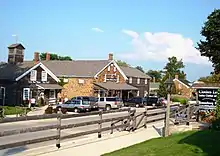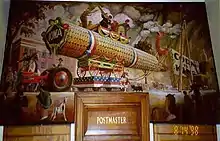Iowa
Iowa (/ˈaɪoʊwə/ (![]() listen))[7][8][9] is a state in the Midwestern region of the United States, bordered by the Mississippi River to the east and the Missouri River and Big Sioux River to the west. It is bordered by six states: Wisconsin to the northeast, Illinois to the east and southeast, Missouri to the south, Nebraska to the west, South Dakota to the northwest, and Minnesota to the north.
listen))[7][8][9] is a state in the Midwestern region of the United States, bordered by the Mississippi River to the east and the Missouri River and Big Sioux River to the west. It is bordered by six states: Wisconsin to the northeast, Illinois to the east and southeast, Missouri to the south, Nebraska to the west, South Dakota to the northwest, and Minnesota to the north.
Iowa | |
|---|---|
| State of Iowa | |
 Flag  Seal | |
| Nickname: | |
| Motto(s): Our liberties we prize and our rights we will maintain. | |
| Anthem: "The Song of Iowa" | |
 Map of the United States with Iowa highlighted | |
| Country | United States |
| Before statehood | American Indians of Iowa Iowa Territory |
| Admitted to the Union | December 28, 1846 (29th) |
| Capital (and largest city) | Des Moines |
| Largest metro and urban areas | Des Moines[lower-alpha 1] |
| Government | |
| • Governor | Kim Reynolds (R) |
| • Lieutenant Governor | Adam Gregg (R) |
| Legislature | Iowa General Assembly |
| • Upper house | Senate |
| • Lower house | House of Representatives |
| Judiciary | Iowa Supreme Court |
| U.S. senators | Chuck Grassley (R) Joni Ernst (R) |
| U.S. House delegation | 1: Ashley Hinson (R) 2: Mariannette Miller-Meeks (R) 3: Cindy Axne (D) 4: Randy Feenstra (R) (list) |
| Area | |
| • Total | 55,857.1 sq mi (144,669.2 km2) |
| • Rank | 26th |
| Dimensions | |
| • Length | 310 mi (499 km) |
| • Width | 240 mi (322 km) |
| Elevation | 1,100 ft (340 m) |
| Highest elevation | 1,671 ft (509 m) |
| Lowest elevation | 480 ft (146 m) |
| Population (2022) | |
| • Total | 3,190,369[5] |
| • Rank | 31st |
| • Density | 57.1/sq mi (22.0/km2) |
| • Rank | 36th |
| • Median household income | $61,691[6] |
| • Income rank | 30th |
| Demonym | Iowan |
| Language | |
| • Official language | English |
| Time zone | UTC−06:00 (Central) |
| • Summer (DST) | UTC−05:00 (CDT) |
| USPS abbreviation | IA |
| ISO 3166 code | US-IA |
| Latitude | 40° 23′ N to 43° 30′ N |
| Longitude | 90° 8′ W to 96° 38′ W |
| Website | www |
| Iowa state symbols | |
|---|---|
 Flag of Iowa | |
 | |
| Living insignia | |
| Bird | Eastern goldfinch |
| Flower | Prairie rose |
| Tree | Bur oak |
| Inanimate insignia | |
| Rock | Geode |
| State route marker | |
 | |
| State quarter | |
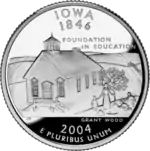 Released in 2004 | |
| Lists of United States state symbols | |
During the 18th and early 19th centuries, Iowa was a part of French Louisiana and Spanish Louisiana; its state flag is patterned after the flag of France. After the Louisiana Purchase, people laid the foundation for an agriculture-based economy in the heart of the Corn Belt.[10] In the latter half of the 20th century, Iowa's agricultural economy transitioned to a diversified economy of advanced manufacturing, processing, financial services, information technology, biotechnology, and green energy production.[11][12]
Iowa is the 26th most extensive in total area and the 31st most populous of the 50 U.S. states, with a population of 3,190,369,[13] according to the 2020 census. The state's capital, most populous city, and largest metropolitan area fully located within the state is Des Moines. A portion of the larger Omaha, Nebraska, metropolitan area extends into three counties of southwest Iowa.[14] Iowa has been listed as one of the safest U.S. states in which to live.[15]
Etymology
Iowa derives its name from the Ioway people, one of the many Native American nations whose territory comprised the future state at the time of European colonization.[16]
History
Prehistory

When American Indians first arrived in what is now Iowa more than 13,000 years ago, they were hunters and gatherers living in a Pleistocene glacial landscape. By the time European explorers and traders visited Iowa, American Indians were largely settled farmers with complex economic, social, and political systems. This transformation happened gradually. During the Archaic period (10,500 to 2,800 years ago), American Indians adapted to local environments and ecosystems, slowly becoming more sedentary as populations increased.[17]
More than 3,000 years ago, during the Late Archaic period, American Indians in Iowa began utilizing domesticated plants. The subsequent Woodland period saw an increased reliance on agriculture and social complexity, with increased use of mounds, ceramics, and specialized subsistence. During the Late Prehistoric period (beginning about AD 900) increased use of maize and social changes led to social flourishing and nucleated settlements.[17]
The arrival of European trade goods and diseases in the Protohistoric period led to dramatic population shifts and economic and social upheaval, with the arrival of new tribes and early European explorers and traders. There were numerous Indian tribes living in Iowa at the time of early European exploration. Tribes which were probably descendants of the prehistoric Oneota include the Dakota, Ho-Chunk, Ioway, and Otoe. Tribes which arrived in Iowa in the late prehistoric or protohistoric periods include the Illiniwek, Meskwaki, Omaha, and Sauk.[17]
Early colonization and trade, 1673–1808
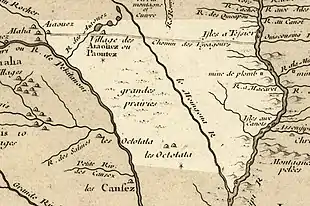
The first known European explorers to document Iowa were Jacques Marquette and Louis Jolliet who traveled the Mississippi River in 1673 documenting several Indigenous villages on the Iowa side.[18][19] The area of Iowa was claimed for France and remained a French territory until 1763. The French, before their impending defeat in the French and Indian War, transferred ownership to their ally, Spain.[20] Spain practiced very loose control over the Iowa region, granting trading licenses to French and British traders, who established trading posts along the Mississippi and Des Moines Rivers.[18]
Iowa was part of a territory known as La Louisiane or Louisiana, and European traders were interested in lead and furs obtained by Indigenous people. The Sauk and Meskwaki effectively controlled trade on the Mississippi in the late 18th century and early 19th century. Among the early traders on the Mississippi were Julien Dubuque, Robert de la Salle, and Paul Marin.[18] Along the Missouri River at least five French and English trading houses were built before 1808.[21] In 1800, Napoleon Bonaparte took control of Louisiana from Spain in a treaty.[22]
After the 1803 Louisiana Purchase, Congress divided the Louisiana Purchase into two parts—the Territory of Orleans and the District of Louisiana, with present-day Iowa falling in the latter. The Indiana Territory was created in 1800 to exercise jurisdiction over this portion of the District; William Henry Harrison was its first governor. Much of Iowa was mapped by Zebulon Pike in 1805,[23] but it was not until the construction of Fort Madison in 1808 that the U.S. established tenuous military control over the region.[24]
War of 1812 and unstable U.S. control
Fort Madison was built to control trade and establish U.S. dominance over the Upper Mississippi, but it was poorly designed and disliked by the Sauk and Fox, many of whom allied with the British, who had not abandoned claims to the territory.[24][25] Fort Madison was defeated by British-supported Indigenous people in 1813 during the War of 1812, and Fort Shelby in Prairie du Chien, Wisconsin, also fell to the British. Black Hawk took part in the siege of Fort Madison.[26][27] Another small military outpost was established along the Mississippi River in present-day Bellevue. This poorly situated stockade was similarly attacked by hundreds of Indigenous people in 1813, but was successfully defended and later abandoned until settlers returned to the area in the mid-1830s.[28]
After the war, the U.S. re-established control of the region through the construction of Fort Armstrong, Fort Snelling in Minnesota, and Fort Atkinson in Nebraska.[29]
Indian removal, 1814–1832
The United States encouraged settlement of the east side of the Mississippi and removal of Indians to the west.[30] A disputed 1804 treaty between Quashquame and William Henry Harrison (then governor of the Indiana Territory) that surrendered much of Illinois to the U.S. enraged many Sauk and led to the 1832 Black Hawk War.[31]
The Sauk and Meskwaki sold their land in the Mississippi Valley during 1832 in the Black Hawk Purchase[32] and sold their remaining land in Iowa in 1842, most of them moving to a reservation in Kansas.[31] Many Meskwaki later returned to Iowa and settled near Tama, Iowa; the Meskwaki Settlement remains to this day. In 1856 the Iowa Legislature passed an unprecedented act allowing the Meskawki to purchase the land.[33] However, in contrast to the unprecedented act of the Iowa Legislature, the United States Federal Government, through the use of Treaties, forced the Ho-Chunk from Iowa in 1848,[34] and forced the Dakota from Iowa by 1858.[35] Western Iowa around modern Council Bluffs was used as an Indian Reservation for members of the Council of Three Fires.[36]
U.S. settlement and statehood, 1832–1860
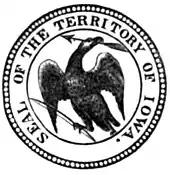
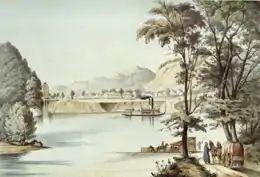
The first American settlers officially moved to Iowa in June 1833.[37] Primarily, they were families from Ohio, Pennsylvania, New York, Indiana, Kentucky, and Virginia who settled along the western banks of the Mississippi River, founding the modern day cities of Dubuque and Bellevue.[37][38] On July 4, 1838, the U.S. Congress established the Territory of Iowa. President Martin Van Buren appointed Robert Lucas governor of the territory, which at the time had 22 counties and a population of 23,242.[39]
Almost immediately after achieving territorial status, a clamor arose for statehood. On December 28, 1846, Iowa became the 29th state in the Union when President James K. Polk signed Iowa's admission bill into law. Once admitted to the Union, the state's boundary issues resolved, and most of its land purchased from Natives, Iowa set its direction to development and organized campaigns for settlers and investors, boasting the young frontier state's rich farmlands, fine citizens, free and open society, and good government.[40]
Iowa has a long tradition of state and county fairs. The first and second Iowa State Fairs were held in the more developed eastern part of the state at Fairfield. The first fair was held October 25–27, 1854, at a cost of around $323. Thereafter, the fair moved to locations closer to the center of the state and in 1886 found a permanent home in Des Moines. The State Fair has been held annually since then, except for a few exceptions: 1898 due to the Spanish–American War and the World's Fair being held in nearby Omaha, Nebraska; from 1942 to 1945, due to World War II, as the fairgrounds were being used as an army supply depot; and in 2020 due to the COVID-19 pandemic in the United States.[41][42]
Civil War, 1861–1865
Iowa supported the Union during the Civil War, voting heavily for Abraham Lincoln, though there was an antiwar "Copperhead" movement in the state, caused partially by a drop in crop prices caused by the war.[43] There were no battles in the state, although the Battle of Athens, Missouri, 1861, was fought just across the Des Moines River from Croton, Iowa, and shots from the battle landed in Iowa. Iowa sent large supplies of food to the armies and the eastern cities.[44]
Much of Iowa's support for the Union can be attributed to Samuel J. Kirkwood, its first wartime governor. Of a total population of 675,000, about 116,000 men were subjected to military duty. Iowa contributed proportionately more men to Civil War military service than did any other state, north or south, sending more than 75,000 volunteers to the armed forces, over one-sixth of whom were killed before the Confederates surrendered at Appomattox.[44]
Most fought in the great campaigns in the Mississippi Valley and in the South.[45] Iowa troops fought at Wilson's Creek in Missouri, Pea Ridge in Arkansas, Forts Henry and Donelson, Shiloh, Chattanooga, Chickamauga, Missionary Ridge, and Rossville Gap as well as Vicksburg, Iuka, and Corinth. They served with the Army of the Potomac in Virginia and fought under Union General Philip Sheridan in the Shenandoah Valley. Many died and were buried at Andersonville. They marched on General Nathaniel Banks' ill-starred expedition to the Red River. Twenty-seven Iowans have been awarded the Medal of Honor, the highest military decoration awarded by the United States government, which was first awarded in the Civil War.[46]
Iowa had several brigadier generals and four major generals—Grenville Mellen Dodge, Samuel R. Curtis, Francis J. Herron, and Frederick Steele—and saw many of its generals go on to state and national prominence following the war.[44]
Agricultural expansion, 1865–1930
Following the Civil War, Iowa's population continued to grow dramatically, from 674,913 people in 1860[47] to 1,624,615 in 1880.[48] The American Civil War briefly brought higher profits.[49]
In 1917, the United States entered World War I and farmers as well as all Iowans experienced a wartime economy. For farmers, the change was significant. Since the beginning of the war in 1914, Iowa farmers had experienced economic prosperity, which lasted until the end of the war.[49] In the economic sector, Iowa also has undergone considerable change. Beginning with the first industries developed in the 1830s,[50] which were mainly for processing materials grown in the area,[51] Iowa has experienced a gradual increase in the number of business and manufacturing operations.
Depression, World War II and manufacturing, 1930–1985
The transition from an agricultural economy to a mixed economy happened slowly. The Great Depression and World War II accelerated the shift away from smallholder farming to larger farms, and began a trend of urbanization. The period after World War II witnessed a particular increase in manufacturing operations.[52]
In 1975, Governor Robert D. Ray petitioned President Ford to allow Iowa to accept and resettle Tai Dam refugees fleeing the Indochina War.[53] An exception was required for this resettlement as State Dept policy at the time forbid resettlement of large groups of refugees in concentrated communities; an exception was ultimately granted and 1200 Tai Dam were resettled in Iowa. Since then Iowa has accepted thousands of refugees from Laos, Cambodia, Thailand, Bhutan, and Burma.[54]
The farm crisis of the 1980s caused a major recession in Iowa, causing poverty not seen since the Depression.[55] The crisis spurred a major, decade-long population decline.[56]
Reemergence as a mixed economy, 1985–present
After bottoming out in the 1980s, Iowa's economy began to reduce its dependence on agriculture. By the early 21st century, it was characterized by a mix of manufacturing, biotechnology, finance and insurance services, and government services.[57] The population of Iowa has increased at a slower rate than the U.S. as a whole since at least the 1900 census,[58] though Iowa now has a predominantly urban population.[59] The Iowa Economic Development Authority, created in 2011 has replaced the Iowa Department of Economic Development and its annual reports are a source of economic information.[60]
Geography
Boundaries
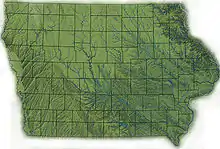
Iowa is bordered by the Mississippi River on the east and the Missouri River and the Big Sioux River on the west. The northern boundary is a line along 43 degrees, 30 minutes north latitude.[61][lower-alpha 2] The southern border is the Des Moines River and a not-quite-straight line along approximately 40 degrees 35 minutes north, as decided by the U.S. Supreme Court in Missouri v. Iowa (1849) after a standoff between Missouri and Iowa known as the Honey War.[62][63]
Iowa is the only state whose east and west borders are formed almost entirely by rivers.[64] Carter Lake, Iowa, is the only city in the state located west of the Missouri River.[65]
Iowa has 99 counties, but 100 county seats because Lee County has two. The state capital, Des Moines, is in Polk County.[66]
Geology and terrain
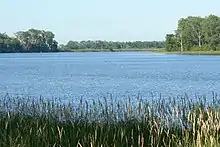
Iowa's bedrock geology generally decreases in age from east to west. In northwest Iowa, Cretaceous bedrock can be 74 million years old; in eastern Iowa Cambrian bedrock dates to c. 500 million years ago.[67] The oldest radiometrically dated bedrock in the state is the 2.9 billion year old Otter Creek Layered Mafic Complex. Precambrian rock is exposed only in the northwest of the state.[68]
Iowa can be divided into eight landforms based on glaciation, soils, topography, and river drainage.[69] Loess hills lie along the western border of the state, some of which are several hundred feet thick.[70] Northeast Iowa along the Upper Mississippi River is part of the Driftless Area, consisting of steep hills and valleys which appear as mountainous.[71]
Several natural lakes exist, most notably Spirit Lake, West Okoboji Lake, and East Okoboji Lake in northwest Iowa (see Iowa Great Lakes). To the east lies Clear Lake. Man-made lakes include Lake Odessa,[72] Saylorville Lake, Lake Red Rock, Coralville Lake, Lake MacBride, and Rathbun Lake. Before European settlement, 4 to 6 million acres of the state was covered with wetlands, about 95% of these wetlands have been drained.[73]
Ecology and environment

Iowa's natural vegetation is tallgrass prairie and savanna in upland areas, with dense forest and wetlands in flood plains and protected river valleys, and pothole wetlands in northern prairie areas.[69] Most of Iowa is used for agriculture; crops cover 60% of the state, grasslands (mostly pasture and hay with some prairie and wetland) cover 30%, and forests cover 7%; urban areas and water cover another 1% each.[74]
The southern part of Iowa is categorized as the Central forest-grasslands transition ecoregion.[75] The Northern, drier part of Iowa is categorized as part of the Central tall grasslands.[76]
There is a dearth of natural areas in Iowa; less than 1% of the tallgrass prairie that once covered most of Iowa remains intact; only about 5% of the state's prairie pothole wetlands remain, and most of the original forest has been lost.[77] As of 2005 Iowa ranked 49th of U.S. states in public land holdings.[78] Threatened or endangered animals in Iowa include the interior least tern, piping plover, Indiana bat, pallid sturgeon, the Iowa Pleistocene land snail, Higgins' eye pearly mussel, and the Topeka shiner.[79] Endangered or threatened plants include western prairie fringed orchid, eastern prairie fringed orchid, Mead's milkweed, prairie bush clover, and northern wild monkshood.[80]
The explosion in the number of high-density livestock facilities in Iowa has led to increased rural water contamination and a decline in air quality.[81]
Other factors negatively affecting Iowa's environment include the extensive use of older coal-fired power plants,[82] fertilizer and pesticide runoff from crop production,[83] and diminishment of the Jordan Aquifer.[84]
Climate
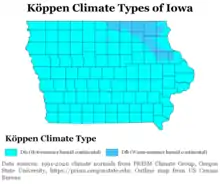
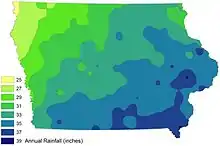
Iowa has a humid continental climate throughout the state (Köppen climate classification Dfa) with extremes of both heat and cold. The average annual temperature at Des Moines is 50 °F (10 °C); for some locations in the north, such as Mason City, the figure is about 45 °F (7 °C), while Keokuk, on the Mississippi River, averages 52 °F (11 °C).[85] Snowfall is common, with Des Moines getting about 26 days of snowfall a year, and other places, such as Shenandoah getting about 11 days of snowfall in a year.[86]
Spring ushers in the beginning of the severe weather season. Iowa averages about 50 days of thunderstorm activity per year.[87] The 30-year annual average of tornadoes in Iowa is 47.[88] In 2008, twelve people were killed by tornadoes in Iowa, making it the deadliest year since 1968 and also the second most tornadoes in a year with 105, matching the total from 2001.[89]
Iowa summers are known for heat and humidity, with daytime temperatures sometimes near 90 °F (32 °C) and occasionally exceeding 100 °F (38 °C). Average winters in the state have been known to drop well below freezing, even dropping below −18 °F (−28 °C). Iowa's all-time hottest temperature of 118 °F (48 °C) was recorded at Keokuk on July 20, 1934, during a nationwide heat wave;[90] the all-time lowest temperature of −47 °F (−44 °C) was recorded in Washta on January 12, 1912.[91]
| City | Jan | Feb | Mar | Apr | May | Jun | Jul | Aug | Sep | Oct | Nov | Dec |
|---|---|---|---|---|---|---|---|---|---|---|---|---|
| Davenport[93] | 30/13 | 36/19 | 48/29 | 61/41 | 72/52 | 81/63 | 85/68 | 83/66 | 76/57 | 65/45 | 48/32 | 35/20 |
| Des Moines[94] | 31/14 | 36/19 | 49/30 | 62/41 | 72/52 | 82/62 | 86/67 | 84/65 | 76/55 | 63/43 | 48/31 | 34/18 |
| Keokuk[95] | 34/17 | 39/21 | 50/30 | 63/42 | 73/52 | 83/62 | 87/67 | 85/65 | 78/56 | 66/44 | 51/33 | 33/21 |
| Mason City[96] | 24/6 | 29/12 | 41/23 | 57/35 | 69/46 | 79/57 | 82/61 | 80/58 | 73/49 | 60/37 | 43/25 | 28/11 |
| Sioux City[97] | 31/10 | 35/15 | 47/26 | 62/37 | 73/49 | 82/59 | 86/63 | 83/63 | 76/51 | 63/38 | 46/25 | 32/13 |
Iowa has a relatively smooth gradient of varying precipitation across the state, with areas in the southeast of the state receiving an average of over 38 inches (97 cm) of rain annually, and the northwest of the state receiving less than 28 inches (71 cm).[98] The pattern of precipitation across Iowa is seasonal, with more rain falling in the summer months. Virtually statewide, the driest month is January or February, and the wettest month is June, owing to frequent showers and thunderstorms, some of which produce hail, damaging winds and/or tornadoes. In Des Moines, roughly in the center of the state, over two-thirds of the 34.72 inches (88.2 cm) of rain falls from April through September, and about half the average annual precipitation falls from May through August, peaking in June.[99]
Settlements
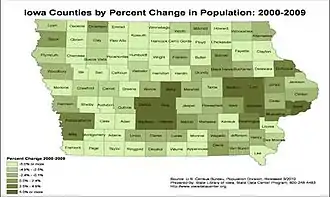
Iowa's population is more urban than rural, with 61 percent living in urban areas in 2000, a trend that began in the early 20th century.[59] Urban counties in Iowa grew 8.5% from 2000 to 2008, while rural counties declined by 4.2%.[101] The shift from rural to urban has caused population increases in more urbanized counties such as Dallas, Johnson, Linn, Polk, and Scott, at the expense of more rural counties.[102]
Iowa, in common with other Midwestern states (especially Kansas, Nebraska, North Dakota, and South Dakota), is feeling the brunt of rural flight, although Iowa has been gaining population since approximately 1990. Some smaller communities, such as Denison and Storm Lake, have mitigated this population loss through gains in immigrant laborers.[103]
Another demographic problem for Iowa is the brain drain, in which educated young adults leave the state in search of better prospects in higher education or employment. During the 1990s, Iowa had the second highest exodus rate for single, educated young adults, second only to North Dakota.[104]
| Rank | City | 2020 city population[105] | 2010 city population[106] | Change | Metropolitan Statistical Area | 2020 metro population[107] | 2010 metro population | 2020 metro change |
|---|---|---|---|---|---|---|---|---|
| 1 | Des Moines | 214,133 | 203,433 | +5.26% | Des Moines–West Des Moines | 707,915 | 606,475 | +16.73% |
| 2 | Cedar Rapids | 137,710 | 126,326 | +9.01% | Cedar Rapids | 273,885 | 257,940 | +6.18% |
| 3 | Davenport | 101,724 | 99,685 | +2.05% | Quad Cities | 382,268 | 379,690 | +0.68% |
| 4 | Sioux City | 85,797 | 82,684 | +3.76% | Sioux City | 144,996 | 143,577 | +0.99% |
| 5 | Iowa City | 74,828 | 67,862 | +10.26% | Iowa City | 175,732 | 152,586 | +15.17% |
| 6 | West Des Moines | 68,723 | 56,609 | +21.40% | Des Moines–West Des Moines | |||
| 7 | Ankeny | 67,887 | 45,582 | +48.93% | Des Moines–West Des Moines | |||
| 8 | Waterloo | 67,314 | 68,406 | −1.60% | Waterloo–Cedar Falls | 168,314 | 167,819 | +0.29% |
| 9 | Ames | 66,427 | 58,965 | +12.65% | Ames | 124,514 | 115,848 | +7.48% |
| 10 | Council Bluffs | 62,799 | 62,230 | +0.91% | Omaha–Council Bluffs | 954,270 | 865,350 | +10.28% |
| 11 | Dubuque | 59,667 | 57,637 | +3.52% | Dubuque | 97,590 | 93,653 | +4.20% |
| 12 | Urbandale | 45,580 | 39,463 | +15.50% | Des Moines–West Des Moines | |||
| 13 | Marion | 41,535 | 34,768 | +19.46% | Cedar Rapids | |||
| 14 | Cedar Falls | 40,713 | 39,260 | +3.70% | Waterloo–Cedar Falls | |||
| 15 | Bettendorf | 39,102 | 33,217 | +17.72% | Quad Cities |
Demographics
Population
| Historical population | |||
|---|---|---|---|
| Census | Pop. | %± | |
| 1840 | 43,112 | — | |
| 1850 | 192,214 | 345.8% | |
| 1860 | 674,913 | 251.1% | |
| 1870 | 1,194,020 | 76.9% | |
| 1880 | 1,624,615 | 36.1% | |
| 1890 | 1,912,297 | 17.7% | |
| 1900 | 2,231,853 | 16.7% | |
| 1910 | 2,224,771 | −0.3% | |
| 1920 | 2,404,021 | 8.1% | |
| 1930 | 2,470,939 | 2.8% | |
| 1940 | 2,538,268 | 2.7% | |
| 1950 | 2,621,073 | 3.3% | |
| 1960 | 2,757,537 | 5.2% | |
| 1970 | 2,824,376 | 2.4% | |
| 1980 | 2,913,808 | 3.2% | |
| 1990 | 2,776,755 | −4.7% | |
| 2000 | 2,926,324 | 5.4% | |
| 2010 | 3,046,355 | 4.1% | |
| 2020 | 3,190,369 | 4.7% | |
| Source: 1910–2020[58] | |||
The United States Census Bureau determined the population of Iowa was 3,190,369 on April 1, 2020, a 4.73% increase since the 2010 United States census.[108]
Of the residents of Iowa, 70.8% were born in Iowa, 23.6% were born in a different U.S. state, 0.6% were born in Puerto Rico, U.S. Island areas, or born abroad to American parent(s), and 5% were foreign born.[109]
Immigration from outside the United States resulted in a net increase of 29,386 people, while migration within the country produced a net loss of 41,140 people. 6.5% of Iowa's population were reported as under the age of five, 22.6% under 18, and 14.7% were 65 or older. Males made up approximately 49.6% of the population.[110] The population density of the state is 52.7 people per square mile.[111] As of the 2010 census, the center of population of Iowa is in Marshall County, near Melbourne.[112]
As of the 2010 census, the population of Iowa was 3,046,355. The gender makeup of the state was 49.5% male and 50.5% female. 23.9% of the population were under the age of 18; 61.2% were between the ages of 18 and 64; and 14.9% were 65 years of age or older.[113]
| Race and Ethnicity[114] | Alone | Total | ||
|---|---|---|---|---|
| White (non-Hispanic) | 82.7% | 85.9% | ||
| Hispanic or Latino[lower-alpha 3] | — | 6.8% | ||
| African American (non-Hispanic) | 4.1% | 5.2% | ||
| Asian | 2.4% | 3.0% | ||
| Native American | 0.3% | 1.4% | ||
| Pacific Islander | 0.2% | 0.3% | ||
| Other | 0.3% | 1.0% | ||

- 50–60%60–70%70–80%80–90%90%+
| Racial composition | 1990[115] | 2000[116] | 2010[117] |
|---|---|---|---|
| White | 96.6% | 93.9% | 91.3% |
| Black or African American | 1.7% | 2.1% | 2.9% |
| American Indian and Alaska Native | 0.3% | 0.3% | 0.4% |
| Asian | 0.9% | 1.3% | 1.7% |
| Native Hawaiian and Other Pacific Islander | — | — | 0.1% |
| Other race | 0.5% | 1.3% | 1.8% |
| Two or more races | — | 1.1% | 1.8% |
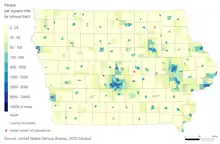
According to the 2016 American Community Survey, 5.6% of Iowa's population were of Hispanic or Latino origin (of any race): Mexican (4.3%), Puerto Rican (0.2%), Cuban (0.1%), and other Hispanic or Latino origin (1.0%).[118] The five largest ancestry groups were: German (35.1%), Irish (13.5%), English (8.2%), American (5.8%), and Norwegian (5.0%).[119]
Birth data
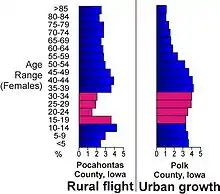
Note: Births in table don't add up, because Hispanics are counted both by their ethnicity and by their race, giving a higher overall number.
| Race | 2013[121] | 2014[122] | 2015[123] | 2016[124] | 2017[125] | 2018[126] | 2019[127] | 2020[128] |
|---|---|---|---|---|---|---|---|---|
| non-Hispanic White | 32,302 (82.6%) | 32,423 (81.7%) | 32,028 (81.1%) | 31,376 (79.6%) | 30,010 (78.1%) | 29,327 (77.6%) | 29,050 (77.2%) | 27,542 (76.3%) |
| Black | 2,232 (5.7%) | 2,467 (6.2%) | 2,597 (6.6%) | 2,467 (6.3%) | 2,657 (6.9%) | 2,615 (6.9%) | 2,827 (7.5%) | 2,685 (7.4%) |
| Asian | 1,353 (3.5%) | 1,408 (3.5%) | 1,364 (3.4%) | 1,270 (3.2%) | 1,321 (3.4%) | 1,176 (3.1%) | 1,106 (2.9%) | 1,067 (2.9%) |
| American Indian | 269 (0.7%) | 284 (0.7%) | 242 (0.6%) | 147 (0.4%) | 311 (0.8%) | 152 (0.4%) | 308 (0.8%) | 143 (0.4%) |
| Hispanic (of any race) | 3,175 (8.1%) | 3,315 (8.3%) | 3,418 (8.6%) | 3,473 (8.8%) | 3,527 (9.2%) | 3,694 (9.8%) | 3,695 (9.8%) | 3,725 (10.3%) |
| Total Iowa | 39,094 (100%) | 39,687 (100%) | 39,482 (100%) | 39,403 (100%) | 38,430 (100%) | 37,785 (100%) | 37,649 (100%) | 36,114 (%) |
- Since 2016, data for births of White Hispanic origin are not collected, but included in one Hispanic group; persons of Hispanic origin may be of any race.
Religion
A 2014 survey by Pew Research Center found 60% of Iowans are Protestant, while 18% are Catholic, and 1% are of non-Christian religions. 21% responded with non-religious, and 1% did not answer.[129][130] A survey from the Association of Religion Data Archives (ARDA) in 2010 found that the largest Protestant denominations were the United Methodist Church with 235,190 adherents and the Evangelical Lutheran Church in America with 229,557. The largest non-Protestant religion was Catholicism with 503,080 adherents. The state has a great number of Calvinist denominations. The Presbyterian Church (USA) had almost 290 congregations and 51,380 members followed by the Reformed Church in America with 80 churches and 40,000 members, and the United Church of Christ had 180 churches and 39,000 members.[131]
The study Religious Congregations & Membership: 2000[132] found in the southernmost two tiers of Iowa counties and in other counties in the center of the state, the largest religious group was the United Methodist Church; in the northeast part of the state, including Dubuque and Linn counties (where Cedar Rapids is located), the Catholic Church was the largest; and in ten counties, including three in the northern tier, the Evangelical Lutheran Church in America was the largest. The study also found rapid growth in Evangelical Christian denominations. Dubuque is home to the Archdiocese of Dubuque, which serves as the ecclesiastical province for all three other dioceses in the state and for all the Catholics in the entire state of Iowa.
Historically, religious sects and orders who desired to live apart from the rest of society established themselves in Iowa, such as the Amish and Mennonite near Kalona and in other parts of eastern Iowa such as Davis County and Buchanan County.[133] Other religious sects and orders living apart include Quakers around West Branch and Le Grand, German Pietists who founded the Amana Colonies, followers of Transcendental Meditation who founded Maharishi Vedic City, and Order of Cistercians of the Strict Observance monks and nuns at the New Melleray and Our Lady of the Mississippi Abbies near Dubuque.
As of 2016 about 6,000 Jews live in Iowa, with about 3,000 of them in Des Moines.[134]
Language
English is the most common language in Iowa, being the sole language spoken by 91.1% of the population. One of the less common languages spoken is sign language and indigenous speaking. The total amount of sign language spoken is about 2.5% of the general population as of 2017. With indigenous speaking, it is about 0.5% of the population. [135] William Labov and colleagues, in the monumental Atlas of North American English[136] found the English spoken in Iowa divides into multiple linguistic regions. Natives of northern Iowa—including Sioux City, Fort Dodge, and the Waterloo region—tend to speak the dialect linguists call North Central American English, which is also found in North and South Dakota, Minnesota, Wisconsin, and Michigan. Natives of central and southern Iowa—including such cities as Council Bluffs, Davenport, Des Moines, and Iowa City—tend to speak the North Midland dialect also found in eastern Nebraska, central Illinois, and central Indiana.[137] Natives of East-Central Iowa—including cities such as Cedar Rapids, Dubuque, and Clinton tend to speak with the Northern Cities Vowel Shift, a dialect that extends from this area and east across the Great Lakes Region.[138]
After English, Spanish is the second-most-common language spoken in Iowa, with 120,000 people in Iowa of Hispanic or Latino origin and 47,000 people born in Latin America.[139] The third-most-common language is German, spoken by 17,000 people in Iowa; two notable German dialects used in Iowa include Amana German spoken around the Amana Colonies, and Pennsylvania German, spoken among the Amish in Iowa. The Babel Proclamation of 1918 banned the speaking of German in public. Around Pella, residents of Dutch descent once spoke the Pella Dutch dialect.
Attractions
Central Iowa

Ames is the home of Iowa State University, the Iowa State Center, and Reiman Gardens.
Des Moines is the largest city and metropolitan area[lower-alpha 1] in Iowa and the state's political and economic center. It is home to the Iowa State Capitol, the State Historical Society of Iowa Museum, Drake University, Des Moines Art Center, Greater Des Moines Botanical Garden, Principal Riverwalk, the Iowa State Fair, Terrace Hill, and the World Food Prize. Nearby attractions include Adventureland and Prairie Meadows Racetrack Casino in Altoona, Living History Farms in Urbandale, Trainland USA in Colfax, and the Iowa Speedway and Valle Drive-In in Newton.

Boone hosts the biennial Farm Progress Show and is home to the Mamie Doud Eisenhower museum, the Boone & Scenic Valley Railroad, and Ledges State Park.
The Meskwaki Settlement west of Tama is the only American Indian settlement in Iowa and is host to a large annual Pow-wow.
Madison County is known for its covered bridges. Also in Madison County is the John Wayne Birthplace Museum is in Winterset.
Other communities with vibrant historic downtown areas include Newton, Indianola, Pella, Knoxville, Marshalltown, Perry, and Story City.
Eastern Iowa


Iowa City is home to the University of Iowa, which includes the Iowa Writers' Workshop, and the Old Capitol building. Because of the extraordinary history in the teaching and sponsoring of creative writing that emanated from the Iowa Writers' Workshop and related programs, Iowa City was the first American city designated by the United Nations as a "City of Literature" in the UNESCO Creative Cities Network.[140]
The Herbert Hoover National Historic Site and Herbert Hoover Presidential Library and Museum are in West Branch.
The Amana Colonies are a group of settlements of German Pietists comprising seven villages listed as National Historic Landmarks.
The Cedar Rapids Museum of Art has collections of paintings by Grant Wood and Marvin Cone. Cedar Rapids is also home to the National Czech & Slovak Museum & Library and Iowa's only National Trust for Historic Preservation Site, Brucemore mansion.

Davenport boasts the Figge Art Museum, River Music Experience, Putnam Museum, Davenport Skybridge, Quad City Symphony Orchestra, Ballet Quad Cities, and plays host to the annual Bix Beiderbecke Memorial Jazz Festival, and the Quad City Air Show, which is the largest airshow in the state.
Other communities with vibrant historic downtown areas include West Liberty, Fairfield, Burlington, Mount Pleasant, Fort Madison, LeClaire, Mount Vernon, Ottumwa, Washington, and Wilton.
Along Interstate 80 near Walcott lies the world's largest truck stop, Iowa 80.
Western Iowa
Some of the most dramatic scenery in Iowa is found in the unique Loess Hills which are found along Iowa's western border.

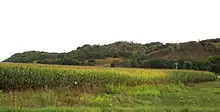
Sioux City is the largest city in western Iowa and is found on the convergence of the Missouri, Floyd, and Big Sioux Rivers. The Sioux City Metropolitan Area encompasses areas in three states: Iowa, Nebraska, and South Dakota. Sioux City boasts a revitalized downtown and includes attractions such as the Hard Rock Hotel and Casino, Sergeant Floyd Monument, Sergeant Floyd River Museum, the Tyson Events Center, Southern Hills Mall, the Orpheum Theater, and more. The historic downtown area is also filled with multiple restaurants, bars, and other entertainment venues. Sioux City is home to two higher education institutions, Morningside College and Briar Cliff University. Le Mars is in the northeastern part of the Sioux City Metropolitan Area and is the self-proclaimed "Ice Cream Capital of the World". Le Mars is home to Wells Enterprises, one of the largest ice cream manufacturers in the world. Attractions in Le Mars include the Wells Visitor Center and Ice Cream Parlor, Archie's Wayside (steak house), Bob's Drive Inn, Tonsfeldt Round Barn, Plymouth County Fairgrounds, Plymouth County Museum, and Plymouth County Courthouse. Le Mars hosts multiple ice cream-themed community events each year.
Council Bluffs, part of the Omaha (Nebr.) Metropolitan Area and a hub of southwest Iowa sits at the base of the Loess Hills National Scenic Byway. With three casino resorts, the city also includes such cultural attractions as the Western Hills Trails Center, Union Pacific Railroad Museum, the Grenville M. Dodge House, The Black Angel, and the Lewis and Clark Monument, with clear views of the Downtown Omaha skyline found throughout the city.
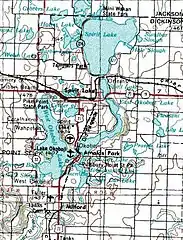
The Iowa Great Lakes is made up of multiple small towns, such as Spirit Lake, Arnolds Park, Milford, and Okoboji. Multiple resorts and other tourist attractions are found in and around these towns surrounding the popular lakes. Arnolds Park, one of the oldest amusement parks in the country, is located on Lake Okoboji in Arnolds Park.

The Sanford Museum and Planetarium in Cherokee, Grotto of the Redemption in West Bend, The Danish Immigrant Museum in Elk Horn, and the Fort Museum and Frontier Village in Fort Dodge are other regional destinations.
Every year in early May, the city of Orange City holds the annual Tulip Festival, a celebration of the strong Dutch heritage in the region.[141]
Northwest Iowa is home to some of the largest concentrations of wind turbine farms in the world. Other western communities with vibrant historic downtown areas include Storm Lake, Spencer, Glenwood, Carroll, Harlan, Atlantic, Red Oak, Denison, Creston, Mount Ayr, Sac City, and Walnut.
Northeast and Northern Iowa
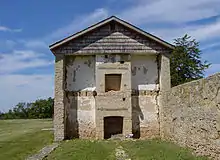
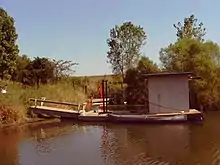
The Driftless Area of northeast Iowa has many steep hills and deep valleys, checkered with forest and terraced fields. Effigy Mounds National Monument in Allamakee and Clayton Counties has the largest assemblage of animal-shaped prehistoric mounds in the world.
Waterloo is home of the Grout Museum and Lost Island Theme Park and is headquarters of the Silos & Smokestacks National Heritage Area. Cedar Falls is home of the University of Northern Iowa.
Dubuque is a regional tourist destination with attractions such as the National Mississippi River Museum and Aquarium and the Port of Dubuque.
Dyersville is home to the famed Field of Dreams baseball diamond. Maquoketa Caves State Park, near Maquoketa, contains more caves than any other state park.
Fort Atkinson State Preserve in Fort Atkinson has the remains of an original 1840s Dragoon fortification.
Fort Dodge is home of The Fort historical museum and the Blanden Art Museum, and host Frontiers Days which celebrate the town history.
Other communities with vibrant historic downtown areas include Decorah, McGregor, Mason City, Elkader, Bellevue, Guttenberg, Algona, Spillville, Charles City, and Independence.
Statewide
Iowa Historic Bike Ride RAGBRAI, the Register's Annual Great Bicycle Ride Across Iowa, attracts thousands of bicyclists and support personnel. It has crossed the state on various routes each year since 1973. Iowa is home to more than 70 wineries,[142] and hosts five regional wine tasting trails.[143] Many Iowa communities hold farmers' markets during warmer months; these are typically weekly events, but larger cities can host multiple markets.[144]
Economy
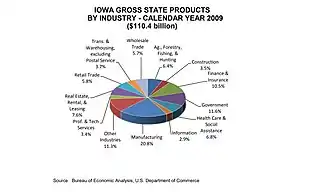
- In 2016,[146] the total employment of the state's population was 1,354,487, and the total number of employer establishments was 81,563.
CNBC's list of "Top States for Business in 2010" has recognized Iowa as the sixth best state in the nation. Scored in 10 individual categories, Iowa was ranked first when it came to the "Cost of Doing Business"; this includes all taxes, utility costs, and other costs associated with doing business. Iowa was also ranked 10th in "Economy", 12th in "Business Friendliness", 16th in "Education", 17th in both "Cost of Living" and "Quality of Life", 20th in "Workforce", 29th in "Technology and Innovation", 32nd in "Transportation" and the lowest ranking was 36th in "Access to Capital".[147]
While Iowa is often viewed as a farming state, agriculture is a relatively small portion of the state's diversified economy, with manufacturing, biotechnology, finance and insurance services, and government services contributing substantially to Iowa's economy.[57] This economic diversity has helped Iowa weather the late 2000s recession better than most states, with unemployment substantially lower than the rest of the nation.[148][149]
If the economy is measured by gross domestic product, in 2005 Iowa's GDP was about $124 billion.[150] If measured by gross state product, for 2005 it was $113.5 billion.[151] Its per capita income for 2006 was $23,340.[151]
On July 2, 2009, Standard & Poor's rated the state of Iowa's credit as AAA (the highest of its credit ratings, held by only 11 U.S. state governments).[152]
As of September 2021, the state's unemployment rate is 4.0%.[153]
Manufacturing
Manufacturing is the largest sector of Iowa's economy, with $20.8 billion (21%) of Iowa's 2003 gross state product. Major manufacturing sectors include food processing, heavy machinery, and agricultural chemicals. Sixteen percent of Iowa's workforce is dedicated to manufacturing.[57]
Food processing is the largest component of manufacturing. Besides processed food, industrial outputs include machinery, electric equipment, chemical products, publishing, and primary metals. Companies with direct or indirect processing facilities in Iowa include ConAgra Foods, Wells Blue Bunny, Barilla, Heinz, Tone's Spices, General Mills, and Quaker Oats. Meatpacker Tyson Foods has 11 locations, second only to its headquarter state Arkansas.[154]
Major non-food manufacturing firms with production facilities in Iowa include 3M,[155] Arconic,[156] Amana Corporation,[157] Emerson Electric,[158] The HON Company,[159] SSAB,[160] John Deere,[161] Lennox Manufacturing,[162] Pella Corporation,[163] Procter & Gamble,[164] Vermeer Company,[165] and Winnebago Industries.[166]
Agriculture
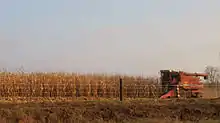
.jpg.webp)
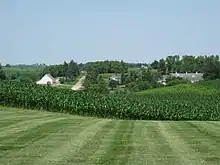
Though industrial-scale, commodity agriculture predominates in much of the state, Iowa has seen growth in the organic farming sector. Iowa ranks fifth in the nation in total number of organic farms. In 2016, there were approximately 732 organic farms in the state, an increase of about 5% from the previous year, and 103,136 organic acres, an increase of 9,429 from the previous year.[167][168] Iowa has also seen an increase in demand for local, sustainably-grown food. Northeast Iowa, part of the Driftless Area, has led the state in development of its regional food system and grows and consumes more local food than any other region in Iowa.[169][170]
Iowa's Driftless Region is also home to the nationally recognized Seed Savers Exchange, a non-profit seed bank housed at an 890-acre heritage farm near Decorah, in the northeast corner of the state.[171][172] The largest nongovernmental seed bank of its kind in the United States, Seed Savers Exchange safeguards more than 20,000 varieties of rare, heirloom seeds.[173]
As of 2007, the direct production and sale of conventional agricultural commodities contributed only about 3.5% of Iowa's gross state product.[175] In 2002 the impact of the indirect role of agriculture in Iowa's economy, including agriculture-affiliated business, was calculated at 16.4% in terms of value added and 24.3% in terms of total output. This was lower than the economic impact of non-farm manufacturing, which accounted for 22.4% of total value added and 26.5% of total output.[176] Iowa's main conventional agricultural commodities are hogs, corn, soybeans, oats, cattle, eggs, and dairy products. Iowa is the nation's largest producer of ethanol and corn and some years is the largest grower of soybeans. In 2008, the 92,600 farms in Iowa produced 19% of the nation's corn, 17% of the soybeans, 30% of the hogs, and 14% of the eggs.[177]
As of 2009 major Iowa agricultural product processors include Archer Daniels Midland, Cargill, Inc., Diamond V Mills, and Quaker Oats.[178]
Health insurance
As of 2014, there were 16 organizations offering health insurance products in Iowa, per the State of Iowa Insurance Division.[179] Iowa was fourth out of ten states with the biggest drop in competition levels of health insurance between 2010 and 2011, per the 2013 annual report on the level of competition in the health insurance industry by the American Medical Association[180] using 2011 data from HealthLeaders-Interstudy, the most comprehensive source of data on enrollment in health maintenance organization (HMO), preferred provider organization (PPO), point-of-service (POS) and consumer-driven health care plans.[181] According to the AMA annual report from 2007 Wellmark Blue Cross Blue Shield had provided 71% of the state's health insurance.[182]
The Iowa Insurance Division "Annual report to the Iowa Governor and the Iowa Legislature" from November 2014 looked at the 95% of health insurers by premium, which are 10 companies. It found Wellmark Inc. to dominate the three health insurance markets it examined (individual, small group and large group) at 52–67%.[183]: 2 Wellmark HealthPlan of Iowa and Wellmark Inc had the highest risk-based capital percentages of all 10 providers at 1158% and 1132%, respectively.[183]: 31 Rising RBC is an indication of profits.[183]: 31
Other sectors

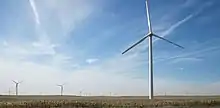
Iowa has a strong financial and insurance sector, with approximately 6,100 firms,[57] including AEGON, Nationwide Group, Aviva USA, Farm Bureau Financial Services, Voya Financial, Marsh Affinity Group, MetLife, Principal Financial Group, Principal Capital Management, Wells Fargo, and University of Iowa Community Credit Union.
Iowa is host to at least two business incubators, Iowa State University Research Park and the BioVentures Center at the University of Iowa.[184] The Research Park hosts about 50 companies, among them NewLink Genetics, which develops cancer immunotherapeutics, and the U.S. animal health division of Boehringer Ingelheim, Vetmedica.[184]
Ethanol production consumes about a third of Iowa's corn production, and renewable fuels account for eight percent of the state's gross domestic product. A total of 39 ethanol plants produced 3.1 billion US gallons (12,000,000 m3) of fuel in 2009.[185]
Renewable energy has become a major economic force in northern and western Iowa, with wind turbine electrical generation increasing exponentially since 1990.[12] In 2019, wind power in Iowa accounted for 42% of electrical energy produced, and 10,201 megawatts of generating capacity had been installed at the end of the year.[186] Iowa ranked first of U.S. states in percentage of total power generated by wind and second in wind generating capacity behind Texas.[186] Major producers of turbines and components in Iowa include Acciona Energy of West Branch, TPI Composites of Newton, and Siemens Energy of Fort Madison.
In 2016, Iowa was the headquarters for three of the top 2,000 companies for revenue.[187] They include Principal Financial, Rockwell Collins, and American Equity Investment.[188][189][190] Iowa is also headquarters to other companies including Hy-Vee, Pella Corporation, Vermeer Company, Kum & Go gas stations, Von Maur, Pioneer Hi-Bred, and Fareway.[191][192][193][194][195][196][197]
Taxation
Tax is collected by the Iowa Department of Revenue.[198]
Iowa imposes taxes on net state income of individuals, estates, and trusts. There are nine income tax brackets, ranging from 0.36% to 8.98%, as well as four corporate income tax brackets ranging from 6% to 12%, giving Iowa the country's highest marginal corporate tax rate.[199] The state sales tax rate is 6%, with non-prepared food having no tax.[200] Iowa has one local option sales tax that may be imposed by counties after an election.[201] Property tax is levied on the taxable value of real property. Iowa has more than 2,000 taxing authorities. Most property is taxed by more than one taxing authority. The tax rate differs in each locality and is a composite of county, city or rural township, school district and special levies. Iowa allows its residents to deduct their federal income taxes from their state income taxes.[202]
Education
Primary and secondary schools
Iowa was one of the leading states in the high school movement, and continues to be among the top educational performers today.[203]
The four-year graduation rate for high schoolers was 91.3% in 2017.[204] Iowa's schools are credited with the highest graduation rate in the nation as of 2019.[205] Iowa has 333 school districts,[204] 1,329 school buildings and has the 14th lowest student-to-teacher ratio of 14.2.[206] Teacher pay is ranked 22nd, with the average salary being $55,647.[206]
As of 2015 transportation spending is a significant part of the budgets of rural school districts as many are geographically large and must transport students across vast distances. This reduces the amount of money spent on other aspects of the districts.[207]
The state's oldest functioning school building is located in Bellevue in the historic Jackson County Courthouse which has been in continuous use as a school since 1848.[208]
Colleges and universities

The Iowa Board of Regents is composed of nine citizen volunteers appointed by the governor to provide policymaking, coordination, and oversight of the state's three public universities, two special K–12 schools, and affiliated centers.[209]
The special K–12 schools include the Iowa School for the Deaf in Council Bluffs and the Iowa Braille and Sight Saving School in Vinton.[209] Both Iowa State University and The University of Iowa are research universities[210] and members of the prestigious Association of American Universities.[211] In addition to the three state universities, Iowa has multiple private colleges and universities.
Transportation
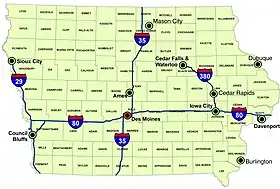
Interstate highways
Iowa has four primary interstate highways. Interstate 29 (I-29) travels along the state's western edge through Council Bluffs and Sioux City. I-35 travels from the Missouri state line to the Minnesota state line through the state's center, including Des Moines. I-74 begins at I-80 just northeast of Davenport. I-80 travels from the Nebraska state line to the Illinois state line through the center of the state, including Council Bluffs, Des Moines, Iowa City, and the Quad Cities. I-380 is an auxiliary Interstate Highway, which travels from I-80 near Iowa City through Cedar Rapids ending in Waterloo and is part of the Avenue of the Saints highway. Iowa is among the few jurisdictions where municipalities install speed cameras on interstate highways providing a substantial revenue source from out of state drivers.[212]
Airports with scheduled flights
Iowa is served by several regional airports including the Des Moines International Airport, the Eastern Iowa Airport, in Cedar Rapids, Quad City International Airport, in Moline, Illinois, and Eppley Airfield, in Omaha, Nebraska. Smaller airports in the state include the Davenport Municipal Airport (Iowa), Dubuque Regional Airport, Fort Dodge Regional Airport, Mason City Municipal Airport, Sioux Gateway Airport, Southeast Iowa Regional Airport, and Waterloo Regional Airport.[213]
Railroads
Amtrak's California Zephyr serves southern Iowa with stops in Burlington, Mount Pleasant, Ottumwa, Osceola, and Creston along its route between Chicago and Emeryville, California.[214] Fort Madison is served by Amtrak's Southwest Chief, running between Chicago and Los Angeles.[215] Both trains currently run tri-weekly and are expected to return to daily service in June.[216]
Public Transit
Iowa is served by a number of local transit providers including Bettendorf Transit, Cambus, Cedar Rapids Transit, Coralville Transit, Cyride, Davenport Citibus, Des Moines Area Regional Transit, Iowa City Transit, The Jule, MET Transit, Omaha Metro Transit, Ottumwa Transit Authority, Quad Cities MetroLINK and Sioux City Transit.
Intercity bus service in the state is provided by Burlington Trailways and Jefferson Lines.
Law and government
State

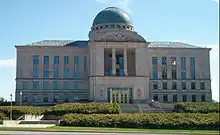
As of 2018, the 43rd and current Governor of Iowa is Kim Reynolds (R). Other statewide elected officials are:
- Adam Gregg (R), Lieutenant Governor
- Paul Pate (R), Secretary of State
- Rob Sand (D), Auditor of State
- Michael Fitzgerald (D), Treasurer of State
- Mike Naig (R), Secretary of Agriculture
- Tom Miller (D), Attorney General
The Code of Iowa contains Iowa's statutory laws. It is periodically updated by the Iowa Legislative Service Bureau, with a new edition published in odd-numbered years and a supplement published in even-numbered years.
Iowa is an alcohol monopoly or alcoholic beverage control state.
National
The two U.S. Senators:
- Chuck Grassley (R), in office since 1981
- Joni Ernst (R), in office since 2015
The four U.S. Representatives:
- Ashley Hinson (R), First district
- Mariannette Miller-Meeks (R), Second district
- Cindy Axne (D), Third district
- Randy Feenstra (R), Fourth district
After the 2010 United States Census and the resulting redistricting, Iowa lost one seat in Congress, falling to four seats in the U.S. House of Representatives. Incumbent U.S. Representatives Leonard Boswell (D) and Tom Latham (R) ran against each other in 2012 in the third congressional district which had new boundaries; Latham won and retired after the 2014 elections. King represented the old fifth congressional district.
Political parties
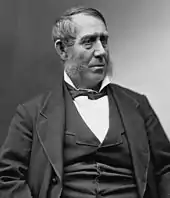
In Iowa, the term "political party" refers to political organizations which have received two percent or more of the votes cast for president or governor in the "last preceding general election". Iowa recognizes three political parties—the Republican Party, the Democratic Party, and the Libertarian Party.[217] The Libertarian Party obtained official political party status in 2017 as a result of presidential candidate Gary Johnson receiving 3.8% of the Iowa vote in the 2016 general election.[218] Third parties, officially termed "nonparty political organizations", can appear on the ballot as well. Four of these have had candidates on the ballot in Iowa since 2004 for various positions: the Constitution Party, the Green Party, the Pirate Party, and the Socialist Workers Party.[219][220]
Voter trends
| Year | Democratic | Republican |
|---|---|---|
| 1976 | 48.5% 619,931 | 49.5% 632,863 |
| 1980 | 38.6% 508,672 | 51.3% 676,026 |
| 1984 | 45.9% 605,620 | 53.3% 703,088 |
| 1988 | 54.7% 670,557 | 44.5% 545,355 |
| 1992 | 43.3% 586,353 | 37.3% 504,891 |
| 1996 | 50.3% 620,258 | 39.9% 492,644 |
| 2000 | 48.5% 638,517 | 48.2% 634,373 |
| 2004 | 49.2% 741,898 | 49.9% 751,957 |
| 2008 | 53.9% 828,940 | 44.4% 682,379 |
| 2012 | 51.9% 822,544 | 46.2% 730,617 |
| 2016 | 41.8% 653,669 | 51.2% 800,983 |
| 2020 | 44.9% 759,061 | 53.1% 897,672 |
As a result of the 2010 elections, each party controlled one house of the Iowa General Assembly: the House had a Republican majority, while the Senate had a Democratic majority. As a result of the 2016 elections, Republicans gained control of the Senate. Incumbent Democratic governor Chet Culver was defeated in 2010 by Republican Terry Branstad, who had served as governor from 1983 to 1999. On December 14, 2015, Branstad became the longest serving governor in U.S. history, serving (at that time) 20 years, 11 months, and 3 days; eclipsing George Clinton, who served 21 years until 1804.[222] Lieutenant Governor Kim Reynolds succeeded him on May 24, 2017, following Branstad's appointment as U.S. Ambassador to China.
| Party registration as of October 1, 2022[223] | |||||
|---|---|---|---|---|---|
| Party | Total voters | Percentage | |||
| Republican | 761,934 | 34.20% | |||
| Nonpartisan | 743,881 | 33.39% | |||
| Democratic | 701,920 | 31.51% | |||
| Other | 19,905 | 0.89% | |||
| Total | 2,227,640 | 100% | |||
Presidential caucus
The state gets considerable attention every four years because the Iowa caucus, gatherings of voters to select delegates to the state conventions, is the first presidential caucus in the country. The caucuses, held in January or February of the election year, involve people gathering in homes or public places and choosing their candidates, rather than casting secret ballots as is done in a presidential primary election.[224] Along with the New Hampshire primary the following week, Iowa's caucuses have become the starting points for choosing the two major-party candidates for president.[225] The national and international media give Iowa and New Hampshire extensive attention, which gives Iowa voters leverage.[226] In 2007 presidential campaign spending was the seventh highest in the country.[227]
Civil rights
In a 2020 study, Iowa was ranked as the 24th easiest state for citizens to vote in.[228]
Racial equality
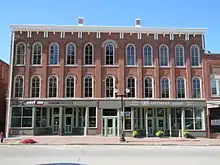
In the 19th century Iowa was among the earliest states to enact prohibitions against race discrimination, especially in education, but was slow to achieve full integration in the 20th century. In the first decision of the Iowa Supreme Court—In Re the Matter of Ralph,[229] decided July 1839—the Court rejected slavery in a decision that found a slave named Ralph became free when he stepped on Iowa soil, 26 years before the end of the Civil War.[230] The state did away with racial barriers to marriage in 1851, more than 100 years before the U.S. Supreme Court would ban miscegenation statutes nationwide.[231]
The Iowa Supreme Court decided Clark v. The board of directors[232] in 1868, ruling that racially segregated "separate but equal" schools had no place in Iowa, 85 years before Brown v. Board of Education.[230] By 1875, a number of additional court rulings effectively ended segregation in Iowa schools.[233] Social and housing discrimination continued against Blacks at state universities until the 1950s.[234] The Court heard Coger v. The North Western Union Packet Co.[235] in 1873, ruling against racial discrimination in public accommodations 91 years before the U.S. Supreme Court reached the same decision.[230]
In 1884, the Iowa Civil Rights Act apparently outlawed discrimination by businesses, reading: "All persons within this state shall be entitled to the full and equal enjoyment of the accommodations, advantages, facilities, and privileges of inns, restaurants, chophouses, eating houses, lunch counters, and all other places where refreshments are served, public conveyances, barber shops, bathhouses, theaters, and all other places of amusement." However, the courts chose to narrowly apply this act, allowing de facto discrimination to continue.[236] Racial discrimination at public businesses was not deemed illegal until 1949, when the court ruled in State of Iowa v. Katz that businesses had to serve customers regardless of race; the case began when Edna Griffin was denied service at a Des Moines drugstore.[237] Full racial civil rights were codified under the Iowa Civil Rights Act of 1965.[238]
Women's rights
As with racial equality, Iowa was a vanguard in women's rights in the mid-19th century, but did not allow women the right to vote until the Nineteenth Amendment to the United States Constitution was ratified in 1920, Iowa legislature being one of the ratifying votes.[239] In 1847, the University of Iowa became the first public university in the U.S. to admit men and women on an equal basis.[240] In 1869, Iowa became the first state in the union to admit women to the practice of law, with the Court ruling women may not be denied the right to practice law in Iowa and admitting Arabella A. Mansfield to the practice of law.[230] Several attempts to grant full voting rights to Iowa women were defeated between 1870 and 1919. In 1894 women were given "partial suffrage", which allowed them to vote on issues, but not for candidates. It was not until the ratification of the Nineteenth Amendment that women had full suffrage in Iowa.[241] Although Iowa supported the Federal Equal Rights Amendment, in 1980 and 1992 Iowa voters rejected an Equal Rights Amendment to the state constitution.[242] Iowa added the word "women" to the Iowa Constitution in 1998. After the amendment, it reads: "All men and women are, by nature, free and equal, and have certain inalienable rights—among which are those of enjoying and defending life and liberty, acquiring, possessing and protecting property, and pursuing and obtaining safety and happiness."[243]
In May 2018 Iowa signed into law one of the country's most restrictive abortion bans: the requirement that a doctor cannot perform an abortion if they can detect a fetal heartbeat, which in many cases would restrict abortions pregnancies less than six weeks old.[244] It was struck down in January 2019, when an Iowa state judge ruled that the "fetal heartbeat" law was unconstitutional.[245]
LGBT rights
The state's law criminalizing same-sex sexual activity was repealed in June 1976, 27 years before Lawrence v. Texas. In 2007, the Iowa Legislature added "sexual orientation" and "gender identity" to the protected classes listed in the Iowa Civil Rights Act.[246]
On April 3, 2009, the Iowa Supreme Court decided Varnum v. Brien,[247] holding in a unanimous decision,[248] the state's law forbidding same-sex marriage was unconstitutional. This made Iowa the third state in the U.S. and first in the Midwest to permit same-sex marriage.[249] [250]
Culture
Arts
.jpg.webp)

The Clint Eastwood movie The Bridges of Madison County, based on the popular novel of the same name, took place and was filmed in Madison County.[251] What's Eating Gilbert Grape, based on the Peter Hedges novel of the same name, is set in the fictional Iowa town of Endora. Hedges was born in West Des Moines.[252]
Des Moines is home to members of the famous metal band Slipknot. The state is mentioned in the band's songs, and the album Iowa is named after the state.[253]
Sports
The state has four major college teams playing in NCAA Division I for all sports. In football, Iowa State University and the University of Iowa compete in the Football Bowl Subdivision (FBS), whereas the University of Northern Iowa and Drake University compete in the Football Championship Subdivision (FCS). Although Iowa has no professional major league sports teams, Iowa has minor league sports teams in baseball, basketball, hockey, and other sports.
The following table shows the Iowa sports teams with average attendance over 8,000. All the following teams are NCAA Division I football, basketball, or wrestling teams:[254][255][256][257][258]
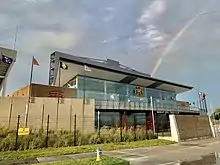
| Team | Location | Avg. Attendance |
|---|---|---|
| Iowa Hawkeyes football | Iowa City | 68,043 |
| Iowa State Cyclones football | Ames | 56,010 |
| Iowa State Cyclones men's basketball | Ames | 14,099 |
| Iowa Hawkeyes men's basketball | Iowa City | 12,869 |
| Iowa Hawkeyes wrestling | Iowa City | 12,568 |
| Iowa State Cyclones women's basketball | Ames | 9,573 |
| Northern Iowa Panthers football | Cedar Falls | 9,337 |
College sports
The state has four NCAA Division I college teams. In NCAA FBS, the University of Iowa Hawkeyes play in the Big Ten Conference[259] and the Iowa State University Cyclones compete in the Big 12 Conference.[260] The two intrastate rivals compete annually for the Cy-Hawk Trophy as part of the Iowa Corn Cy-Hawk Series.[261]
In wrestling, the Iowa Hawkeyes and Iowa State Cyclones have won a combined total of over 30 team NCAA Division I titles.[262][263] The Northern Iowa and Cornell College wrestling teams have also each won one NCAA Division I wrestling team title.[264][265]
In NCAA FCS, the University of Northern Iowa Panthers play at the Missouri Valley Conference[266] and Missouri Valley Football Conference[267] (despite the similar names, the conferences are administratively separate), whereas the Drake University Bulldogs play at the Missouri Valley Conference[268] in most sports and Pioneer League for football.[269]

Baseball
Des Moines is home to the Iowa Cubs, a Triple-A Minor League Baseball team of the International League and affiliate of the Chicago Cubs.[270][271] Iowa has two High-A minor league teams in the High-A Central: the Cedar Rapids Kernels and the Quad Cities River Bandits.[272] The Sioux City Explorers are part of the American Association of Professional Baseball.[273]
Ice hockey
Des Moines is home to the Iowa Wild, who are affiliated with the Minnesota Wild and are members of the American Hockey League.[274] Coralville has an ECHL team called the Iowa Heartlanders as the 2021–22 season.
The United States Hockey League has five teams in Iowa: the Cedar Rapids RoughRiders, Sioux City Musketeers, Waterloo Black Hawks, Des Moines Buccaneers, and the Dubuque Fighting Saints.[275] The North Iowa Bulls of the North American Hockey League (NAHL) and the Mason City Toros of the North American 3 Hockey League (NA3HL) both play in Mason City.[276][277]
Soccer
- The Des Moines Menace of the USL League Two play their home games at Drake Stadium (Drake University) in Des Moines, Iowa.[278]
- The Drake Bulldogs have a men's[279] and women's soccer team.[280]
- the Cedar Rapids Inferno Soccer Club of the Midwest Premier League play their home games at Robert W. Plaster Athletic Complex at Mount Mercy University
- the Iowa Raptors FC of the USL League Two play their home games at K. Raymond Clark Field at Coe College
- Union Dubuque F.C. of the Midwest Premier League
Other sports
Iowa has two professional basketball teams. The Iowa Wolves, an NBA G League team that plays in Des Moines, is owned and affiliated with the Minnesota Timberwolves of the NBA. The Sioux City Hornets play in the American Basketball Association.
Iowa has three professional football teams. The Sioux City Bandits play in the Champions Indoor Football league. The Iowa Barnstormers play in the Indoor Football League at Wells Fargo Arena in Des Moines. The Cedar Rapids Titans play in the Indoor Football League at the U.S. Cellular Center.
The Iowa Speedway oval track has hosted auto racing championships such as the IndyCar Series, NASCAR Nationwide Series and NASCAR Truck Series since 2006. Also, the Knoxville Raceway dirt track hosts the Knoxville Nationals, one of the classic sprint car racing events.
The John Deere Classic is a PGA Tour golf event held in the Quad Cities since 1971. The Principal Charity Classic is a Champions Tour event since 2001. The Des Moines Golf and Country Club hosted the 1999 U.S. Senior Open and the 2017 Solheim Cup.
Iowans

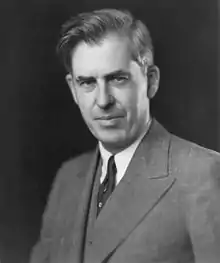
Iowa is the birthplace of U.S. President Herbert Hoover, Vice President Henry A. Wallace, and two first ladies, Lou Henry Hoover and Mamie Eisenhower. Other national leaders who lived in Iowa include John L. Lewis, Harry Hopkins, Carrie Chapman Catt, and Chief Black Hawk.
Five Nobel Prize winners that hail from Iowa: Norman Borlaug, recipient of the Nobel Peace Prize; Thomas Cech, recipient of the Nobel Prize in Chemistry; Alan J. Heeger, also a recipient of the Nobel Prize in Chemistry; John Mott, recipient of the Nobel Peace Prize; and Stanley B. Prusiner, recipient of the Nobel Prize in Physiology or Medicine. Other notable scientists who worked or were born in Iowa include astronomer and space pioneer James A. Van Allen, climate scientist James Hansen, ecologist Aldo Leopold, computer pioneer John Vincent Atanasoff, geochemist Clair Cameron Patterson, and Intel co-founder Robert Noyce.
Notable writers, artists, and news personalities born or raised in Iowa include Bill Bryson, George Gallup, Susan Glaspell, Mauricio Lasansky, Tomas Lasansky, Harry Reasoner, and Grant Wood. Twelve Tuskegee Airmen from World War II hailed from Iowa, including Robert Martin.
Musicians, actors, and entertainers born or raised in Iowa include Tom Arnold, Julia Michaels, Bix Beiderbecke, Johnny Carson, Buffalo Bill Cody, Simon Estes, Nathan Jonas Jordison, Corey Taylor, Shawn Crahan, William Frawley, Charlie Haden, Ashton Kutcher, Cloris Leachman, Glenn Miller, Kate Mulgrew, Eric Christian Olsen, Donna Reed, George Reeves, Brandon Routh, Jean Seberg, John Wayne, Brooks Wheelan, Andy Williams, Meredith Willson, Elijah Wood, Jason Momoa, and Hynden Walch.
Olympic gold medal-winning athletes born or raised in Iowa include Dan Gable, Shawn Johnson, and Glen Brand. Iowa athletes inducted into the Baseball Hall of Fame include Cap Anson, Fred Clarke, Red Faber, and Bob Feller. In college football, Jay Berwanger was the first winner of the Downtown Athletic Club Trophy in 1935, later renamed the Heisman Trophy and won by Nile Kinnick in 1939. In professional football, Kurt Warner was the Super Bowl XXXIV MVP winner and a two-time NFL MVP award winner. Frank Gotch was a World Heavyweight Wrestling Champion, Zach Johnson won the 2007 Masters Golf Tournament and the 2015 British Open, and Jeremy Hellickson won the 2011 American League Rookie of the Year award pitching for the Tampa Bay Rays. Former WWE Heavyweight Champion Seth Rollins is from Davenport.[281]
Sister jurisdictions
Iowa has ten official partner jurisdictions:[282]
 Yamanashi Prefecture, Japan (1960)
Yamanashi Prefecture, Japan (1960) Yucatán, Mexico (1964)
Yucatán, Mexico (1964) Hebei Province, People's Republic of China (1983)
Hebei Province, People's Republic of China (1983) Terengganu, Malaysia (1987)
Terengganu, Malaysia (1987) Taiwan, Republic of China (1989)
Taiwan, Republic of China (1989) Stavropol Krai, USSR/Russia (1989)
Stavropol Krai, USSR/Russia (1989) Cherkasy Oblast, Ukraine (1996)
Cherkasy Oblast, Ukraine (1996) Veneto Region, Italy (1997)
Veneto Region, Italy (1997) Republic of Kosovo (2013)
Republic of Kosovo (2013)
See also
- Index of Iowa-related articles
- Outline of Iowa
Notes
- However, a portion of the larger Omaha–Council Bluffs metropolitan area does extend into the state.
- The Missouri and Mississippi river boundaries are as they were mapped in the 19th century, which can vary from their modern courses.
- Persons of Hispanic or Latino origin are not distinguished between total and partial ancestry.
References
- "State Symbols". Iowa Department of Economic Development. Archived from the original on September 2, 2011. Retrieved September 9, 2011.
- "Iowa Quick Facts". Iowa Data Center. State Library of Iowa. Archived from the original on May 1, 2021. Retrieved April 28, 2021.
- "Elevations and Distances in the United States". United States Geological Survey. 2001. Archived from the original on November 2, 2011. Retrieved October 21, 2011.
- Elevation adjusted to North American Vertical Datum of 1988.
- "2020 Census Apportionment Results". United States Census Bureau. Archived from the original on April 26, 2021. Retrieved April 27, 2021.
- "Iowa Profile". U.S. Census Bureau. U.S. Census Bureau. Archived from the original on March 4, 2021. Retrieved April 28, 2021.
- "Iowa". Merriam-Webster Dictionary. Retrieved May 14, 2017.
- "Iowa". The American Heritage Dictionary of the English Language (5th ed.). HarperCollins. Retrieved May 14, 2017.
- "Iowa". Lexico UK English Dictionary. Oxford University Press. Archived from the original on March 22, 2020.
- Merry, Carl A. (1996). "The Historic Period". Office of the State Archeologist at the University of Iowa. Archived from the original on June 4, 2009. Retrieved June 29, 2009.
- "Major Industries in Iowa" (PDF). Iowa Department of Economic Development. Archived from the original (PDF) on May 20, 2005. Retrieved June 29, 2009.
- "Wind Energy in Iowa". Iowa Energy Center. Archived from the original on June 21, 2009. Retrieved August 8, 2009.
- "Resident Population for the 50 States, the District of Columbia, and Puerto Rico: 2020 Census" (PDF). Census.gov. April 27, 2021. Archived (PDF) from the original on April 26, 2021. Retrieved April 27, 2021.
- United States Census Bureau. "Metropolitan and Micropolitan Statistical Areas Population Totals: 2010–2018". Archived from the original on June 2, 2019. Retrieved June 7, 2019.
- "N.H. Receives Lowest Crime Ranking; Nevada Ranks as Worst State". Insurance Journal. Wells Publishing. March 25, 2009. Archived from the original on March 15, 2012. Retrieved August 8, 2009.
- Alex, Lynn M. (2000). Iowa's Archaeological Past. University of Iowa Press, Iowa City.
- Alex, Lynn M. (2000) Iowa's Archaeological Past. University of Iowa Press, Iowa City.
- Peterson, Cynthia L. (2009). "Historical Tribes and Early Forts". In William E. Whittaker (ed.). Frontier Forts of Iowa: Indians, Traders, and Soldiers, 1682–1862. Iowa City: University of Iowa Press. pp. 12–29. ISBN 978-1-58729-831-8. Archived from the original on August 17, 2016. Retrieved May 31, 2014.
- History of Iowa, Iowa Official Register, Publications.iowa.gov Archived September 3, 2009, at the Wayback Machine
- Herbermann, Charles. The Catholic Encyclopedia: An International Work of Reference on the Constitution, Doctrine, Discipline, and History of the Catholic Church. Encyclopedia Press, 1913, p. 380 (Original from Harvard University).
- Carlson, Gayle F. (2009). "Fort Atkinson, Nebraska, 1820–1827, and Other Missouri River Sites". In William E. Whittaker (ed.). Frontier Forts of Iowa: Indians, Traders, and Soldiers, 1682–1862. Iowa City: University of Iowa Press. pp. 104–120. ISBN 978-1-58729-831-8. Archived from the original on August 17, 2016. Retrieved May 31, 2014.
- "Treaty of San Ildefonso 1800". Napoleon-series.org. Archived from the original on November 6, 2020. Retrieved April 14, 2020.
- Pike (1965): The expeditions of Zebulon Montgomery Pike to headwaters of the Mississippi River, through Louisiana Territory, and in New Spain, during the years June 7, 1805, Ross & Haines
- McKusick, Marshall B. (2009). "Fort Madison, 1808–1813". In William E. Whittaker (ed.). Frontier Forts of Iowa: Indians, Traders, and Soldiers, 1682–1862. Iowa City: University of Iowa Press. pp. 55–74. ISBN 978-1-58729-831-8. Archived from the original on August 17, 2016. Retrieved May 31, 2014.
- Prucha, Francis P. (1969) The Sword of the Republic: The United States Army on the Frontier 1783–1846. Macmillan, New York.
- Jackson, Donald (1960), A Critic's View of Old Fort Madison, Iowa Journal of History and Politics 58(1) pp.31–36
- Black Hawk (1882) Autobiography of Ma-Ka-Tai-Me-She-Kia-Kiak or Black Hawk. Continental Printing, St. Louis. (Originally published 1833)
- The History of Jackson County, Iowa, Containing a History of the County, Its Cities, Towns, &c., Biographical Sketches of Citizens. Chicago: Western Historical Co. 1879. p. 531.
- Whittaker, William E., ed. (2009). Frontier Forts of Iowa: Indians, Traders, and Soldiers, 1682–1862. Iowa City: University of Iowa Press. ISBN 978-1-58729-831-8. Archived from the original on August 17, 2016. Retrieved May 31, 2014.
- Drexler, Ken. "Research Guides: Indian Removal Act: Primary Documents in American History: Introduction". guides.loc.gov. Archived from the original on April 5, 2020. Retrieved April 14, 2020.
- Jung, Patrick J., 1963– (2007). The Black Hawk War of 1832. Norman: University of Oklahoma Press. ISBN 978-0-8061-3811-4. OCLC 70718369.
{{cite book}}: CS1 maint: multiple names: authors list (link) - "INDIAN AFFAIRS: LAWS AND TREATIES Vol. II, Treaties". Archived from the original on September 22, 2017. Retrieved April 14, 2020.
- "History | Meskwaki Nation". Archived from the original on April 12, 2020. Retrieved April 14, 2020.
- Reicher, Matt (March 15, 2019). "Ho-Chunk and Long Prairie, 1846–1855". Mnopedia. Archived from the original on June 11, 2020. Retrieved April 14, 2020.
- "Minnesota Treaties | The U.S.-Dakota War of 1862". Usdakotawar.org. August 14, 2012. Archived from the original on August 25, 2019. Retrieved April 14, 2020.
- Clifton, James A.; Cornell, George L.; McClurken, James M. (1986), People of the Three Fires (PDF), p. 37, archived (PDF) from the original on May 18, 2017, retrieved April 14, 2020
- Schwieder, Dorothy. "History of Iowa". Iowa State University. Archived from the original on September 3, 2009. Retrieved June 6, 2009.
- "Jackson County, Iowa History Information". Jackson County, Iowa. Archived from the original on November 4, 2019. Retrieved November 3, 2019.
- Iowa Official Register, Volume Number 60, page 314
- "Official Encouragement of Immigration to Iowa", Marcus L. Hansen, IJHP, 19 (April 1921):159–95
- "Iowa State Fair". Trivia. Archived from the original on November 30, 2010. Retrieved December 12, 2010.
- "Safety". Iowa State Fair. Archived from the original on October 16, 2020. Retrieved October 13, 2020.
- Lendt, David L. "Iowa and the Copperhead Movement." The Annals of Iowa 40 (1970), 412–427. Available at: https://doi.org/10.17077/0003-4827.7965 Archived May 10, 2022, at the Wayback Machine Hosted by Iowa Research Online
- Iowa Official Register, Volume No. 60, page 315
- "Civil War". Iowanationalguard.com. Archived from the original on May 29, 2010. Retrieved July 26, 2010.
- Iowa Official Register, Volume No. 60, pages 315–316
- "1860 Census: Population of the United States" Archived January 21, 2021, at the Wayback Machine. United States Census Bureau. Retrieved October 7, 2019.
- Bureau, US Census. "1880 Census: Volume 1. Statistics of the Population". The United States Census Bureau. Archived from the original on June 11, 2020. Retrieved April 14, 2020.
- "The Economics of Agriculture". Iowa PBS. July 25, 2016. Archived from the original on May 21, 2020. Retrieved April 15, 2020.
- "Types of Business and Industry". Iowa PBS. July 25, 2016. Archived from the original on June 11, 2020. Retrieved April 15, 2020.
- "Early Industry". Iowa PBS. July 25, 2016. Archived from the original on June 11, 2020. Retrieved April 15, 2020.
- Schwieder, Dorothy. "History of Iowa". publications.iowa.gov. Archived from the original on September 3, 2009. Retrieved April 20, 2020.
- Walsh, Matthew. The Good Governor: Robert Ray and the Indochinese Refugees of Iowa (McFarland & Co, 2017)
- Office of Asian and Pacific Islander Affairs, Iowa Department of Human Rights. State of Asian Americans and Pacific Islanders in Iowa, 2015
- The Midwest Farm Crisis of the 1980s, Tripod.com Archived July 6, 2008, at the Wayback Machine
- Population Trends: The Changing Face of Iowa, State.ia.us Archived October 6, 2006, at the Wayback Machine
- Iowa Industries, Iowa Workforce Development. Iowalifechanging.com Archived May 20, 2005, at the Wayback Machine
- "Historical Population Change Data (1910–2020)". Census.gov. United States Census Bureau. Archived from the original on April 29, 2021. Retrieved May 1, 2021.
- Iowa Data Center, 2000 Census: Iowadatacenter.org Archived December 3, 2008, at the Wayback Machine
- "Iowa Economic Development Authority". iowaeconomicdevelopment.com. Archived from the original on August 12, 2014. Retrieved July 26, 2014.
- Preamble to the 1857 Constitution of the State of Iowa. Archived from the original on August 2, 2009. Retrieved August 9, 2009.
- 48 U.S. (7 How.) 660 (1849).
- Morrison, Jeff (January 13, 2005). "Forty-Thirty-five or fight? Sullivan's Line, the Honey War, and latitudinal estimations". Archived from the original on January 1, 2007. Retrieved August 9, 2009.
- "Iowa Fast Facts and Trivia". 50states.com. Archived from the original on January 28, 2013. Retrieved February 24, 2013.
- "About Carter Lake". Archived from the original on October 9, 2020. Retrieved October 7, 2020.
- "National Association of Counties". County Seats. Archived from the original on December 22, 2010. Retrieved December 24, 2010.
- Prior, Jean Cutler. Geology of Iowa: Iowa's Earth History Shaped by Ice, Wind, Rivers, and Ancient Seas. Adapted from Iowa Geology 2007, Iowa Department of Natural Resources. Iowa Department of Natural Resources Geological Survey. Archived from the original on April 16, 2009. Retrieved August 9, 2009.
- Anderson, Wayne I. (1998). Iowa's Geological Past: Three Billion Years of Change. Iowa City: University of Iowa Press. p. 21.
- Prior, Jean C. (1991). Landforms of Iowa. University of Iowa Press, Iowa City. Archived from the original on March 2, 2009.
- "Geology of the Loess Hills, Iowa". United States Geological Survey. July 1999. Archived from the original on March 28, 2008. Retrieved March 26, 2008.
- "Landforms of Iowa" (PDF). Uni.edu. Archived (PDF) from the original on July 31, 2012. Retrieved April 7, 2020.
- "Odessa". Iowa Department of Natural Resources. Archived from the original on September 21, 2008. Retrieved June 6, 2009.
- "Wetlands". Iowadnr.gov. Archived from the original on April 7, 2020. Retrieved April 7, 2020.
- Iowa DNR: Iowa's Statewide Land Cover Inventory, Uiowa.edu Archived May 2, 2009, at the Wayback Machine
- Terrestrial ecoregions of North America : a conservation assessment. Ricketts, Taylor H. Washington, D.C.: Island Press. 1999. ISBN 1-55963-722-6. OCLC 40856986.
{{cite book}}: CS1 maint: others (link) - "Central tall grasslands | Ecoregions | WWF". World Wildlife Fund. Archived from the original on August 10, 2020. Retrieved April 7, 2020.
- Iowa's Threatened and Endangered Species Program, Iowadnr.gov Archived September 24, 2015, at the Wayback Machine
- "Des Moines Register", June 1, 2019 , Iowa Must Step Up Investment in Public Lands Archived July 22, 2011, at the Wayback Machine Nicholasjohnson.org
- Federally Listed Animals in Iowa, Agriculture.state.ia.us Archived September 30, 2011, at the Wayback Machine
- Federally Listed Plants in Iowa, Agriculture.state.ia.us Archived September 30, 2011, at the Wayback Machine
- "Living with Hogs in Rural Iowa". Iowa Ag Review. Iowa State University. 2003. Archived from the original on November 20, 2021. Retrieved November 25, 2009.
- Heldt, Diane (November 24, 2009). "Report: Many Iowa coal plants among nation's oldest". Cedar Rapids Gazette. Archived from the original on December 8, 2012. Retrieved November 25, 2009.
- "Iowa Works to Reduce Run-off Polluting the Gulf of Mexico". The Iowa Journal. Iowa Public Television. September 17, 2009. Archived from the original on November 6, 2009. Retrieved November 25, 2009.
- Love, Orlan (December 6, 2009). "Heavy use draining aquifer". Cedar Rapids Gazette. Archived from the original on December 9, 2009. Retrieved December 20, 2009.
- "Climate Iowa: Temperature, climate graph, Climate table for Iowa - Climate-Data.org". en.climate-data.org. Archived from the original on April 24, 2019. Retrieved April 6, 2020.
- "Average Annual Snowfall Totals in Iowa – Current Results". Currentresults.com. Archived from the original on February 21, 2020. Retrieved April 6, 2020.
- US Thunderstorm distribution. src.noaa.gov. Retrieved February 13, 2008. Archived October 15, 2006, at the Wayback Machine
- "Des Moines, IA". noaa.gov. Archived from the original on August 21, 2014. Retrieved February 18, 2015.
- "2008 Iowa tornadoes deadliest since 1968". USA Today. January 2, 2009. Archived from the original on October 11, 2013. Retrieved January 2, 2009.
- Keokuk Comprehensive Plan 2018 (PDF) (Report). June 2018. Archived (PDF) from the original on February 20, 2021. Retrieved April 6, 2020.
- Munson, Kyle. "Site of Iowa's coldest temp shivers with rest of state". USA TODAY. Archived from the original on February 28, 2020. Retrieved April 6, 2020.
- "Iowa Weather-Iowa Weather Forecast-Iowa Climate". ustravelweather.com. Archived from the original on January 31, 2011. Retrieved February 17, 2011.
- "Monthly Averages for Davenport, Iowa". Weather.com. Archived from the original on October 8, 2008. Retrieved November 1, 2008.
- "Average Weather for Des Moines, IA—Temperature and Precipitation". Weather.com. Archived from the original on October 24, 2012. Retrieved February 18, 2012.
- "Daily Averages for Keokuk, IA". weather.com. Archived from the original on October 24, 2012. Retrieved February 18, 2012.
- "Average Weather for Mason City, IA—Temperature and Precipitation". Weather.com. Archived from the original on October 24, 2012. Retrieved February 18, 2012.
- "Average Weather for Sioux City, IA—Temperature and Precipitation". Weather.com. Archived from the original on October 24, 2012. Retrieved February 18, 2012.
- Average Annual Precipitation Iowa, 1961–1990 (GIF File) Archived February 13, 2010, at the Wayback Machine—Christopher Daly, Jenny Weisburg
- "Average Weather for Des Moines, IA—Temperature and Precipitation, Weather.com, Retrieved Jan. 7, 2009". Weather.com. Archived from the original on December 3, 2010. Retrieved July 31, 2010.
- Data from U.S. Census Bureau, Population Division. Modeled after Iowa Data Center Map, Iowadatacenter.org Archived January 17, 2013, at the Wayback Machine
- Iowans still flocking to cities, census stats show. Cedar Rapids Gazette, June 30, 2009, Gazetteonline.com Archived March 30, 2012, at the Wayback Machine
- U.S. Census Bureau State and County Quick Facts, Census.gov Archived May 27, 2010, at the Wayback Machine
- Grimes, William (September 14, 2005). "In This Small Town in Iowa the Future Speaks Spanish". The New York Times. Archived from the original on February 9, 2014. Retrieved February 19, 2017.
- Iowa Brain Drain, Iowa Civic Analysis Network, University of Iowa, Uiowa.edu Archived April 12, 2012, at the Wayback Machine
- "Annual Estimates of the Resident Population: April 1, 2010 to July 1, 2020". United States Census Bureau. Archived from the original on December 27, 1996. Retrieved June 8, 2021.
- "Population 2010—Iowa Cities". United States Census Bureau. Archived from the original on December 27, 1996. Retrieved August 4, 2011.
- "Estimates of Resident Population Change and Rankings: April 1, 2010 to July 1, 2020—United States—Metropolitan Statistical Area; and for Puerto Rico". United States Census Bureau. Archived from the original on December 27, 1996. Retrieved June 8, 2021.
- "Numeric and Percent Change in Resident Population" (PDF). 2020 Census Apportionment Results. United States Census Bureau, Population Division. April 26, 2021. Archived (PDF) from the original on April 26, 2021. Retrieved April 27, 2021.
- "U.S. Census website". Archived from the original on December 27, 1996. Retrieved January 18, 2020.
- "U.S. Census quickfacts". United States Census Bureau. Archived from the original on May 27, 2010. Retrieved April 2, 2015.
- John W. Wright, ed. (2007). The New York Times 2008 Almanac. p. 178. ISBN 9780143112334.
- Bureau, US Census. "Centers of Population for the 2010 Census". The United States Census Bureau. Archived from the original on June 11, 2020. Retrieved April 27, 2020.
- "2010 Demographic Profile Data". U.S. Census Bureau. Archived from the original on February 13, 2020. Retrieved August 23, 2017.
- "Race and Ethnicity in the United States: 2010 Census and 2020 Census". census.gov. United States Census Bureau. August 12, 2021. Archived from the original on August 15, 2021. Retrieved September 26, 2021.
- "Historical Census Statistics on Population Totals By Race, 1790 to 1990, and By Hispanic Origin, 1970 to 1990, For The United States, Regions, Divisions, and States". Census.gov. Archived from the original on July 25, 2008. Retrieved July 26, 2014.
- "Population of Iowa: Census 2010 and 2000 Interactive Map, Demographics, Statistics, Quick Facts". Censusviewer.com. Archived from the original on March 4, 2016. Retrieved July 26, 2014.
- 2010 Census Data. "2010 Census Data". Census.gov. Archived from the original on May 22, 2017. Retrieved July 26, 2014.
- "2016 American Community Survey—Demographic and Housing Estimates". United States Census Bureau. Archived from the original on February 13, 2020. Retrieved November 21, 2018.
- "2016 American Community Survey—Selected Social Characteristics". United States Census Bureau. Archived from the original on February 13, 2020. Retrieved November 21, 2018.
- Based on 2000 U.S. Census Data.
- Martin JA, Hamilton BE, Osterman MJ, Curtin SC, Mathews TJ (January 15, 2015). National Vital Statistics Reports—Births: Final Data for 2013 (PDF) (Report). Vol. 64. U.S. Department of Health and Human Services. pp. 35–6. Archived (PDF) from the original on September 11, 2017. Retrieved February 3, 2019.
- Hamilton BE, Martin JA, Osterman MJ, Curtin SC, Mathews TJ (December 23, 2015). National Vital Statistics Reports—Births: Final Data for 2014 (PDF) (Report). Vol. 64. U.S. Department of Health and Human Services. pp. 35–6. Archived (PDF) from the original on February 14, 2017. Retrieved February 3, 2019.
- Martin JA, Hamilton BE, Osterman MJ, Driscoll AK (January 5, 2017). National Vital Statistics Reports—Births: Final Data for 2015 (PDF) (Report). Vol. 66. U.S. Department of Health and Human Services. pp. 38, 40. Archived (PDF) from the original on August 31, 2017. Retrieved February 3, 2019.
- Martin JA, Hamilton BE, Osterman MJ, Driscoll AK, Drake P (January 31, 2018). National Vital Statistics Reports—Births: Final Data 2016 (PDF) (Report). Vol. 67. U.S. Department of Health and Human Services. p. 26. Archived (PDF) from the original on June 3, 2018. Retrieved February 3, 2019.
- Martin JA, Hamilton BE, Osterman MJ, Driscoll AK, Drake P (November 7, 2018). National Vital Statistics Reports—Births, by race and origin of mother: United States, each state and territory, 2017 (PDF) (Report). Vol. 67. p. 20. Archived (PDF) from the original on February 1, 2019. Retrieved February 18, 2019.
- Martin, Joyce A.; Hamilton, Brady E.; Osterman, Michelle J.K.; Driscoll, Anne K. (November 27, 2019). Births: Final Data for 2018 (PDF) (Report). Archived (PDF) from the original on November 28, 2019. Retrieved February 26, 2020.
- "Data" (PDF). Cdc.gov. Archived (PDF) from the original on June 23, 2021. Retrieved March 29, 2021.
- "Data" (PDF). www.cdc.gov. Archived (PDF) from the original on February 10, 2022. Retrieved February 21, 2022.
- "Religious composition of adults in Iowa". Pew Research Center. Archived from the original on August 1, 2017. Retrieved August 18, 2019.
- "American Religious Identification Survey 2001" (PDF). The Graduate Center of the City University of New York. Archived from the original (PDF) on May 16, 2012. Retrieved January 4, 2012.
- "The Association of Religion Data Archives | State Membership Report". thearda.com. Archived from the original on November 12, 2013. Retrieved November 12, 2013.
- "Religious Congregations & Membership: 2000". Glenmary Research Center. Archived from the original (jpg) on December 14, 2006. Retrieved April 24, 2009.
- Elmer Schwieder and Dorothy Schwieder (2009) A Peculiar People: Iowa's Old Order Amish University of Iowa Press
- Tapper, Josh (February 3, 2016). "Postville, Iowa's Jewish Community Bounces Back After Immigration Raid". Haaretz. Archived from the original on October 24, 2017. Retrieved October 24, 2017.
- "Explore Census Data". data.census.gov. Archived from the original on May 3, 2021. Retrieved May 3, 2021.
- Labov, W., S. Ash, and C. Boberg, Atlas of North American English. Berlin, Germany: Mouton de Gruyter, 2006. Mouton-online.com Archived December 26, 2007, at the Wayback Machine
- "Atlas of North American English". The University of Pennsylvania. Archived from the original on January 17, 2008. Retrieved January 5, 2008.
- Labov, W., Ash, S., & Boberg, C. (2006). The atlas of North American English: Phonetics, phonology, and sound change: a multimedia reference tool. Berlin: Mouton de Gruyter.
- 2000 U.S. Census: Census.gov Archived December 27, 1996, at the Wayback Machine
- Macdonald, Moira (October 31, 2017). "UNESCO declares Seattle a City of Literature". The Seattle Times. Archived from the original on May 18, 2020. Retrieved April 27, 2020.
- "History Of Tulip Festival". Orange City Tulip Festival. Archived from the original on January 3, 2019. Retrieved April 6, 2020.
- ISU Extension Midwest Grape and Wine Industry Institute, Iastate.edu Archived January 25, 2009, at the Wayback Machine
- Iowa Wine Growers Association, Iowawinegrowers.org Archived November 23, 2010, at the Wayback Machine
- Iowa Farmers Market Association, Iafarmersmarkets.org Archived June 12, 2009, at the Wayback Machine
- "IOWA GROSS STATE PRODUCTS BY INDUSTRY – CALENDAR YEAR 2009 ($110.4 billion)" (PDF). Iowa General Assembly. 2009. Archived (PDF) from the original on July 19, 2021. Retrieved April 8, 2022.
- "QuickFacts: Iowa". Census.gov. U.S. Census Bureau. Archived from the original on November 10, 2019. Retrieved January 1, 2020.
- "America's Top States for Business in 2010". CNBC. Archived from the original on December 26, 2011. Retrieved May 9, 2011.
- Iowa's initial jobless claims grow. Des Moines Register April 2, 2009, Desmoinesregister.com
- City has lowest unemployment in nation, Iowa City Press-Citizen May 5., 2009, Press-citizen.com
- Iowa State University. Gross domestic product by sector and state. Regional Capacity Analysis Program. Retrieved on: April 26, 2008. Archived October 9, 2008, at the Wayback Machine
- "Iowa Quick Facts—State Data Center". Statelibraryofiowa.org. June 28, 2010. Archived from the original on November 4, 2010. Retrieved July 31, 2010.
- Iowa officials tout credit rating, argue it shows state's finances are strong, Associated Press July 3, 2009, Timesrepublican.com Archived September 7, 2010, at the Wayback Machine
- "Iowa's Unemployment Rate Falls To 4.0 Percent In September". October 22, 2021. Archived from the original on November 8, 2021. Retrieved November 8, 2021.
- "Our story-locations". Tysonfoods.com. Archived from the original on July 4, 2014. Retrieved July 16, 2014.
- "3M Plant Locations – United States". 3m.com. Archived from the original on April 18, 2020. Retrieved April 20, 2020.
- DeWitt, Jennifer. "Alcoa Davenport Works to become Arconic". The Quad-City Times. Archived from the original on June 11, 2020. Retrieved April 20, 2020.
- Friestad, Thomas. "Whirlpool Amana plant remaining closed after more positive coronavirus tests". The Gazette. Archived from the original on April 2, 2020. Retrieved April 20, 2020.
- "Fisher | Emerson US". Emerson.com. Archived from the original on April 5, 2020. Retrieved April 20, 2020.
- "Muscatine – HON Headquarters". HON Office Furniture. October 11, 2016. Archived from the original on June 11, 2020. Retrieved April 20, 2020.
- "SSAB Americas". SSAB. Archived from the original on May 13, 2020. Retrieved April 20, 2020.
- "John Deere Factory Tours | John Deere US". Deere.com. Archived from the original on April 17, 2020. Retrieved April 20, 2020.
- "ABOUT LENNOX". Lennox. Archived from the original on March 31, 2020. Retrieved April 20, 2020.
- "IOWA ICON: Pete Kuyper's idea changed the future of his hometown". whotv.com. February 15, 2012. Retrieved April 20, 2020.
- "P&G Iowa City Plant | P&G News | Events, Multimedia, Public Relations". news.pg.com. Archived from the original on May 20, 2020. Retrieved April 20, 2020.
- "Our Locations". Vermeer.com. Archived from the original on June 11, 2020. Retrieved April 20, 2020.
- Gazette, RAE YOST For The Globe. "Winnebago will open new plant outside of Forest City". Globe Gazette | Mason City, Iowa | globegazette.com. Archived from the original on June 11, 2020. Retrieved April 20, 2020.
- Eller, Donnelle (November 3, 2017). "Looking for greater profits, more Iowa farmers move to organic corn, soybeans". The Des Moines Register. Retrieved January 21, 2019.
- "Iowa Organic Association". Archived from the original on April 16, 2019. Retrieved April 16, 2019.
- Northeast Iowa Local Foods Expansion Plan (PDF), Northeast Iowa Resource Conservation and Development, archived (PDF) from the original on January 21, 2019, retrieved January 21, 2019
- Grow The Local Food System, Northeast Iowa Resource Conservation and Development, archived from the original on January 22, 2019, retrieved January 21, 2019
- Saving Seeds, National Geographic, September 27, 2011, archived from the original on April 16, 2019, retrieved April 16, 2019
- Episode 202: Best of Season One—Inspiring PLACES, Growing a Greener World, July 9, 2011, archived from the original on April 16, 2019, retrieved April 16, 2019
- About Us: Today, Seed Saver Exchange, archived from the original on April 16, 2019, retrieved April 16, 2019
- Orr C. Fischer (1941). "The Corn Parade". Archived from the original on June 10, 2010. Retrieved July 3, 2010.
- 2007 Iowa Factbook p. 59, Des Moines:Iowa Legislative Services Agency.
- Swenson, David A; Eathington, Liesl (December 1, 2002). "Multiple Measures of the Role of Agriculture in Iowa's Economy". Iowa State University, Department of Economics. Staff General Research Papers, number 10180. Archived from the original on July 15, 2014. Retrieved July 26, 2014.
- USDA. "Iowa State Fact Sheets". Archived from the original on February 22, 2015. Retrieved February 21, 2015.
- Ford, George (November 28, 2009). "Impact of grain-processing industry runs deep, but people don't see it". Cedar Rapids Gazette. pp. 1A. Archived from the original on December 9, 2012. Retrieved November 29, 2009.
- Iowa Insurance Division (n.d.). "Find an Insurance Company". State of Iowa. Archived from the original on December 21, 2014. Retrieved December 21, 2014.
- AMA (2013). Competition in Health Insurance: A Comprehensive Study of U.S. Markets, 2013 update. AMA. ISBN 978-1-60359-944-3.
- "AMA Analysis Lists States Where One Private Health Insurer Rules" (press release). AMA.org. November 7, 2013. Archived from the original on June 28, 2014. Retrieved June 24, 2014.
- Competition in Health Insurance: 2007 update, Ama-assn.org Archived July 25, 2011, at the Wayback Machine
- Iowa Insurance Division (November 2014). "Annual report to the Iowa Governor and the Iowa Legislature". State of Iowa. Archived from the original on December 21, 2014. Retrieved December 21, 2014.
- Philipiddis, Alex (June 15, 2014). "Incubators Blossom along with Their Startups". Genetic Engineering & Biotechnology News. Vol. 34, no. 12. pp. 7–8. Archived from the original on November 1, 2016. Retrieved July 17, 2016.
- "Ethanol mandate wouldn't help prices". Cedar Rapids Gazette. February 26, 2010. Archived from the original on December 8, 2012. Retrieved April 4, 2010.
- "Electric Power Monthly". U.S. Department of Energy, Energy Information Administration. Archived from the original on February 6, 2018. Retrieved June 2, 2020.
- "The World's Biggest Public Companies". Forbes. Archived from the original on October 2, 2019. Retrieved October 5, 2016.
- "The World's Biggest Public Companies #380". Forbes.com. Archived from the original on September 28, 2016. Retrieved October 5, 2016.
- "The World's Biggest Public Companies #380". Forbes.com. Archived from the original on October 7, 2016. Retrieved October 5, 2016.
- "The World's Biggest Public Companies #380". Forbes.com. Archived from the original on November 13, 2016. Retrieved October 5, 2016.
- "Company Overview of Hy-Vee, Inc". Bloomberg.com. Archived from the original on October 6, 2016. Retrieved October 5, 2016.
- "Company Overview of Pella Corporation". Bloomberg.com. Archived from the original on October 6, 2016. Retrieved October 5, 2016.
- "Company Overview of Vermeer Corporation". Bloomberg.com. Archived from the original on August 26, 2016. Retrieved October 5, 2016.
- "Company Overview of Kum & Go, L.C". Bloomberg.com. Archived from the original on October 6, 2016. Retrieved October 5, 2016.
- Company Overview of Von Maur, Inc, Bloomberg.com, archived from the original on October 6, 2016, retrieved October 5, 2016
- "Company Overview of Pioneer Hi-Bred International, Inc". Bloomberg.com. Archived from the original on October 6, 2016. Retrieved October 5, 2016.
- "Company Overview of Fareway Stores, Inc". Bloomberg.com. Archived from the original on October 6, 2016. Retrieved October 5, 2016.
- "State of Iowa Taxes | Iowa Department of Revenue". tax.iowa.gov. Archived from the original on December 27, 2019. Retrieved April 6, 2020.
- "State Corporate Income Tax Rates and Brackets for 2016—Tax Foundation". February 1, 2016. Archived from the original on February 16, 2017. Retrieved February 24, 2017.
- Iowa Department of Revenue, Iowa Tax / Fee Descriptions and Rates, Iowa.gov Archived May 6, 2009, at the Wayback Machine
- Iowa Department of Revenue, Iowa Local Option Tax Information, Ioawa.gov Archived April 25, 2009, at the Wayback Machine
- Beaumont, Thomas (May 30, 2009). "No tax increases planned for next year, Culver says". The Des Moines Register. Retrieved May 31, 2009.
- Goldin C, Katz LF. Why the United States Led in Education: Lessons from Secondary School Expansion, 1910 to 1940 Archived February 11, 2021, at the Wayback Machine. In: Eltis D, Lewis F, Sokoloff K Human Capital and Institutions. Cambridge University Press ; 2009.
- "About the Iowa Education System". Iowa Department of Education. Archived from the original on November 3, 2019. Retrieved November 3, 2019.
- "Public High School Graduation Rates" (PDF). National Center for Education Statistics. Archived (PDF) from the original on September 24, 2019. Retrieved November 3, 2019.
- "Rankings And Estimates Report 2018" (PDF). National Education Association. Archived (PDF) from the original on November 12, 2019. Retrieved November 3, 2019.
- Boden, Sarah (February 3, 2015). "Lawmakers Scrounge Up Bus Money for Rural School Districts". Iowa Public Radio. Archived from the original on June 17, 2018. Retrieved June 18, 2018.
- "Bellevue school board sets referendum for $16 million bond issuance". Telegraph Herald. Archived from the original on November 3, 2019. Retrieved November 3, 2019.
- "What is the Board of Regents?". Iowaregents.edu. June 22, 2016. Archived from the original on June 11, 2020. Retrieved April 15, 2020.
- "Carnegie Classifications | Standard Listings". carnegieclassifications.iu.edu. Archived from the original on June 11, 2020. Retrieved April 21, 2020.
- "Our Members | Association of American Universities (AAU)". Aau.edu. Archived from the original on November 11, 2021. Retrieved April 21, 2020.
- Belz, Adam (May 13, 2015). "How one city in Iowa caught 160,000 speeders in less than two years". Star Tribune. Retrieved April 6, 2020.
- "Iowa Airport Information | Iowa DOT". Iowadot.gov. Archived from the original on December 23, 2019. Retrieved April 21, 2020.
- "Amtrak California Zephyr - ShareMap.org". sharemap.org. Archived from the original on June 11, 2020. Retrieved April 7, 2020.
- "Passenger trains in America". traveler.sharemap.org. Archived from the original on April 16, 2020. Retrieved April 7, 2020.
- "With Increased Demand and Congressional Funding, Amtrak Restores 12 Long Distance Routes to Daily ServiceWebsite=Media.amrak.com". March 10, 2021. Archived from the original on April 14, 2021. Retrieved April 17, 2021.
- "Forming a Political Party in Iowa". sos.iowa.gov. Iowa Secretary of State Paul D. Pate. Archived from the original on November 7, 2018. Retrieved October 22, 2018.
- "Libertarian Party obtains official political party status in Iowa". sos.iowa.gov. Iowa Secretary of State Paul D. Pate. Archived from the original on October 22, 2018. Retrieved October 22, 2018.
- "Official Results Report—Statewide: 2006 General Election" (PDF). Iowa Secretary of State. Archived from the original (PDF) on July 15, 2007. Retrieved July 26, 2007.
- "Canvass Summary: 2004 General Election" (PDF). Chester J. Culver, Iowa Secretary of State. Archived from the original (PDF) on January 4, 2007. Retrieved July 26, 2007.
- Leip, David. "General Election Results – Iowa". United States Election Atlas. Archived from the original on July 9, 2018. Retrieved January 29, 2021.
- "Terry Branstad just became the longest serving governor in American history". Washington Post. Archived from the original on September 19, 2016. Retrieved September 14, 2016.
- "State of Iowa Voter Registration Totals". Iowa Secretary of State. July 1, 2021. Archived from the original on November 27, 2018. Retrieved September 2, 2022.
- James Q. Lynch (November 19, 2007). "What happens at a caucus?". iowacaucus.com. Archived from the original on December 22, 2007.
- Donovan, Todd; Hunsaker, Rob (January 2009). "Beyond expectations: effects of early elections in U.S. presidential nomination contests". PS: Political Science & Politics. 42 (1): 45–52. doi:10.1017/S1049096509090040. S2CID 42839320. Archived from the original on July 15, 2016. Retrieved January 30, 2016.
- Donovan, Todd; Redlawsk, David; Tolbert, Caroline (September 2014). "The 2012 Iowa Republican Caucus and Its Effects on the Presidential Nomination Contest". Presidential Studies Quarterly. 44 (3): 447–466. doi:10.1111/psq.12132.
- Swenson, David (April 2008), The Economic Impact of the Iowa Caucus: Gauging the Worth of Its First‐in‐the‐Nation Position? (PDF), archived (PDF) from the original on April 4, 2020, retrieved April 22, 2020
- J. Pomante II, Michael; Li, Quan (December 15, 2020). "Cost of Voting in the American States: 2020". Election Law Journal: Rules, Politics, and Policy. 19 (4): 503–509. doi:10.1089/elj.2020.0666. S2CID 225139517. Archived from the original on October 25, 2021. Retrieved January 14, 2022.
- 1 Morris 1 (Iowa 1839)
- "Early Civil Rights Cases". Judicial.state.ia.us. Archived from the original on May 5, 2006. Retrieved July 26, 2010.
- Gay marriage and Iowa: Why's everyone so surprised? Archived April 29, 2009, at the Wayback Machine, Chicago Tribune, April 10, 2009
- 24 Iowa 266 (1868)
- Brodnax, David (2004). "The Equality of Right: Alexander Clark and the Desegregation of Iowa's Public Schools, 1834–1875". Law and Society Association. Archived from the original on July 21, 2009. Retrieved July 22, 2009.
- Breaux, Richard M. (2004) "Maintaining a Home for Girls": The Iowa Federation of Colored Women's Clubs at the University of Iowa 1919–1950, Cultural Capital and Black Education ed. V.P. Franklin and C.J. Savage. Information Age, Greenwich
- 37 Iowa 145 (1873)
- Iowa Civil Rights Commission, Iowa.org Archived June 3, 2010, at the Wayback Machine
- African-Americans in Iowa, 1838–2005, IPTV.org Archived May 6, 2009, at the Wayback Machine
- Iowa Civil Rights Commission, State.ia.us Archived July 20, 2009, at the Wayback Machine
- "Iowa and the 19th Amendment (U.S. National Park Service)". Nps.gov. Archived from the original on July 4, 2019. Retrieved January 21, 2020.
- About Iowa, Uiowa.edu Archived November 19, 2012, at the Wayback Machine
- The Fight for Women's Suffrage, IPTV.org Archived June 15, 2010, at the Wayback Machine
- How Did Iowa Coalitions Campaign for the Equal Rights Amendment in 1980 and 1992?, alexanderstreet.com Archived September 18, 2009, at the Wayback Machine
- 1857 CONSTITUTION OF THE STATE OF IOWA—CODIFIED Archived February 9, 2014, at the Wayback Machine. Search.legis.state.ia.us (July 4, 1973). Retrieved on July 12, 2013.
- Pfannenstiel, Brianne; Petroski, William. "The nation's strictest abortion ban is now law. Iowa Gov. Kim Reynolds signs 'fetal heartbeat' bill". Des Moines Register. Retrieved January 21, 2020.
- Levenson, Eric; Baldacci, Marlena (January 23, 2019). "Iowa's 'fetal heartbeat' abortion restriction declared unconstitutional". CNN. Archived from the original on January 23, 2019. Retrieved January 23, 2019.
- "Iowa Civil Rights Act—Sexual Orientation and Gender Identity" (PDF). State of Iowa. 2016. Archived (PDF) from the original on July 12, 2019. Retrieved June 25, 2019.
- WL 874044 (Iowa 2009) (Publication to N.W.2d pending as of April 9, 2009.)
- Martyn, Chase (August 25, 2008). "Iowa Supreme Court: Same-sex couples can marry " Iowa Independent". Iowaindependent.com. Archived from the original on April 11, 2009. Retrieved July 26, 2010.
- "BREAKING: Iowa Supreme Court rules in favor of marriage equality! " Human Rights Campaign". HRC Back Story. April 3, 2009. Archived from the original on May 2, 2009. Retrieved July 26, 2010.
- "USA Today, Iowa Court Upholds Gay Marriage". USA Today. January 7, 2010. Archived from the original on April 6, 2009. Retrieved July 31, 2010.
- Hughes, Howard, 1971– (2009). Aim for the heart : the films of Clint Eastwood. London: I.B. Tauris. ISBN 978-1-4416-7618-4. OCLC 670430491.
{{cite book}}: CS1 maint: multiple names: authors list (link) - "WEDDINGS; Susan B. Titman, Peter S. Hedges". The New York Times. Archived from the original on May 4, 2019. Retrieved April 6, 2020.
- "Slipknot (band)". Archived from the original on August 1, 2021. Retrieved July 15, 2021.
- 2018 National College Football Attendance Archived July 18, 2019, at the Wayback Machine; Retrieved November 3, 2019.
- 2019 NCAA Men's Basketball Attendance Archived September 5, 2019, at the Wayback Machine; Retrieved November 3, 2019.
- 2019 NCAA Women's Basketball Attendance Archived September 24, 2019, at the Wayback Machine; Retrieved November 3, 2019.
- "Division I Attendance for the 2018–19 Season". April 16, 2019. Archived from the original on November 3, 2019. Retrieved November 3, 2019.
- Hanson, Austin (February 24, 2020). "By the numbers: Hawkeye wrestling's regular season success". The Daily Iowan. Archived from the original on April 6, 2020. Retrieved April 6, 2020.
- "Big Ten Conference | History & Members". Encyclopedia Britannica. Archived from the original on January 26, 2022. Retrieved April 8, 2020.
- "Big 12 Conference | American athletic conference". Encyclopedia Britannica. Archived from the original on June 11, 2020. Retrieved April 8, 2020.
- "Iowa Corn Assumes Lead for Cy-Hawk Series". University of Iowa Athletics. April 12, 2011. Archived from the original on February 20, 2021. Retrieved April 8, 2020.
- Iowa wrestling championships: History and records from the dynasty. ncaa.com. Retrieved October 7, 2022.
- Iowa State National Championships. cyclones.com. Retrieved October 7, 2022.
- 1950 Wrestling Team (2009) - Hall of Fame - UNI Athletics. Retrieved October 7, 2022.
- Palmer, Mark. (September 14, 2007). InterMat Wrestling - InterMat Rewind: 1947 Cornell College. Retrieved October 7, 2022.
- "UNI – Missouri Valley Conference". mvc-sports.com. Archived from the original on June 11, 2020. Retrieved April 23, 2020.
- "2019 Football Standings". valley-football.org. Archived from the original on June 11, 2020. Retrieved April 23, 2020.
- "Drake – Missouri Valley Conference". mvc-sports.com. Archived from the original on May 1, 2020. Retrieved April 23, 2020.
- "The PFL – About the PFL – Pioneer Football League Official Site". Pioneer-Football.org. Archived from the original on May 22, 2020. Retrieved April 23, 2020.
- "The Official Site of the Pacific Coast League". MiLB.com. Archived from the original on May 17, 2020. Retrieved April 27, 2020.
- "Iowa Cubs". MiLB.com. Archived from the original on May 16, 2020. Retrieved April 27, 2020.
- 2019 Midwest League Media Guide, pp. 26–48, archived from the original on March 28, 2019, retrieved April 27, 2020
- "SIOUX CITY EXPLORERS". American Association of Independent Professional Baseball. Archived from the original on April 26, 2020. Retrieved April 27, 2020.
- "Wild AHL Affiliate Moving To Iowa". NHL.com. Archived from the original on June 11, 2020. Retrieved April 27, 2020.
- "Home". USHL. Archived from the original on April 28, 2020. Retrieved April 27, 2020.
- "NORTH IOWA BULLS ANNOUNCE MOVE TO NAHL". North Iowa Bulls. March 5, 2021. Archived from the original on June 2, 2021. Retrieved June 2, 2021.
- "Mason City Toros begin new era in the NA3HL". NA3HL. June 1, 2021. Archived from the original on June 2, 2021. Retrieved June 2, 2021.
- Lawhon, Danny (April 3, 2019). "Des Moines Menace finding new home digs, 'new' league for 2019 season". The Des Moines Register. Retrieved April 28, 2020.
- "Drake University Athletics – Men's Soccer – Drake University". Drake University Athletics. Archived from the original on March 8, 2020. Retrieved April 28, 2020.
- "Drake University Athletics – Women's Soccer – Drake University". Drake University Athletics. Archived from the original on March 9, 2020. Retrieved April 28, 2020.
- "Famous People From Iowa, Famous Natives Sons". Worldatlas.com. Archived from the original on June 11, 2020. Retrieved April 14, 2020.
- "Iowa Sister States". Iowa Sister States. February 23, 2010. Archived from the original on August 9, 2018. Retrieved August 8, 2018.
External links
- Official website

- State Data Center of Iowa population, housing, business and government statistics
- Iowa Travel and Tourism Division
- Iowa State Facts from USDA
- Energy Data & Statistics for Iowa—U.S. Department of Energy
- Iowa State Databases—Annotated list of searchable databases produced by Iowa state agencies and compiled by the Government Documents Roundtable of the American Library Association.
- U.S. Census Bureau Quick Facts
- Iowa at Curlie
 Geographic data related to Iowa at OpenStreetMap
Geographic data related to Iowa at OpenStreetMap
